|
|

June 9, 2000
This document presents the procedures to convert from a Digital Off-Hook (DOH) configuration to a Direct Connect with a POTS splitter configuration. Converting to a Direct Connect with a POTS splitter configuration has the following possible effects on your system:
A Direct Connect with a POTS splitter configuration uses the following POTS splitters:
 |
Note In a Direct Connect with a POTS splitter configuration using a Cisco 6120 and quad-port ATU-C modules, it is necessary to install an additional Cisco 6120 chassis. The additional Cisco 6120 chassis expands the system to accommodate 128 ports. |
These procedures describe the following topics:
This section provides the following prerequisites needed to convert a Cisco 6100 with NI-1 DOH configuration to a Direct Connect with a POTS splitter configuration:
 |
Note For additional site requirements, refer to the Cisco 6100 with NI-1 Direct Connect Installation Guide. |
Table 1 lists the tools and equipment required to convert a Cisco 6100 with NI-1 DOH configuration to a Direct Connect with a POTS splitter configuration.
| Check | Tools and Equipment |
|---|---|
| Hardware Components |
| xTU-C modules (optional—for use if upgrading the current xTU-C modules)
|
| DS3 STM1 (optional—for use when installing a subtended network)—Version 6100-ST-3-DS3= |
| DS3 subtending I/O card (optional—for use when installing a subtended network)—Version 6100-ST-IO-3-DS3= |
| System I/O card—Version 6100-SYS-IO-3= |
| POTS splitter—Required when installing quad-port flexi ATU-C modules in the Cisco 6100
|
| POTS modules—Required when installing quad-port flexi ATU-C modules in the Cisco 6100
|
| Direct Connect NEBS Compliance Kit
|
| Cisco 6100 Thermal Upgrade Kit—Required when installing dual-port DMT-2 ATU-C or quad-port flexi ATU-C modules in the Cisco 6100
|
| Cables to connect the Cisco 6100 to the Cisco 6120 |
| Software Components |
| ViewRunner for Windows or ViewRunner for HP OpenView Release 3.0.0 |
| Tools |
| A 3/16-inch flat-head screwdriver |
| A Phillips-head screwdriver |
| A one-quarter inch socket driver or wrench |
| Necessary equipment for ESD protection—Required whenever you handle Cisco DSLAM2 equipment, which includes the chassis, modules, and cards |
| Mounting screws—To mount the Cisco 6100, Cisco 6120, and fan tray to the rack |
| Standoff screws |
| Backplane screws—Included on the backplane |
| Plastic ESD shield for the DS3 subtending I/O card—Included with the card |
| Wire wrapping tool |
| Wire stripper |
| Wire for connections
|
| Ferrites that yield an impedance of 200 ohms +/-20 percent at 100 MHz Note Ferrites are shipped with the NI-1 module. However, more ferrites are needed when cabling the power connections, the DS3 subtending I/O card, and the system I/O card.
|
| Tie wraps |
| Coaxial cable
|
| Fiber cable—Used to connect the OC-3c NI-1 module |
| 1STM = subtend host module 2DSLAM = digital subscriber line access multiplexer 3AWG = American Wire Gauge |
Two people are needed for lifting, installing, and removing a chassis and some of its components (for example, the rear cover).
 |
Note The Cisco 6100 with NI-1 system has no internal user-serviceable parts. However, you can add or remove a chassis module or a fan module without removing power from the system (hot swapping). |
 |
Warning Only trained and qualified personnel should be allowed to install, replace, or service this equipment. |
The Cisco 6100 with NI-1 system fits in a 23-inch wide rack. See Table 2 for individual rack space requirements.
| Component | Rack Space | Height | Depth |
|---|---|---|---|
Cisco 6100 chassis | 9 RUs1 | 15.75 in. (40.00 cm) | 12 in. (30.48 cm) |
POTS splitter
| 4 RUs | 7 in. (17.78 cm) | 12 in. (30.48 cm) |
Fan tray2 | 2 RUs | 3.5 in. (8.89 cm) | 12 in. (30.48 cm) |
| 1RU = rack unit. One RU is equal to 1.75 inches (4.45 cm). 2Leave 1 RU of space under the fan tray. This space allows for the intake plenum and for cabling back to front for the OC-3c NI-1 module. |
The central office (CO) power source or rectifier supplies external power to the system as -48 VDC from the fuse and alarm panel. Power connections from the fuse and alarm panel are wired separately to the Cisco 6100 chassis and the fan tray. Connections for single- and dual-power feeds are provided. The power input connections are redundant, and only one is absolutely necessary for system operation. The nominal voltage is -48 VDC; the minimum operating value is -36 VDC; and the maximum operating value is -60 VDC.
Before you connect the system to a power source, verify that the power source is properly grounded and it falls within the internal power supply rating.
Depending on your configuration type, calculate the typical power required for each Cisco 6100 Series component. After you calculate the typical power, determine the minimum fuse value for each component that is wired to the fuse and alarm panel. Use Table 3 to calculate the minimum fuse rating that is necessary for each of your Cisco 6100 with NI-1 system components.
 |
Note The power rating label that is supplied on the rear of each chassis and fan tray indicates the maximum fuse value for the chassis or the fan tray. |
| Component | Instructions | Calculation |
|---|---|---|
| Cisco 6100 Chassis1,2 | ||
| 1a | If you are using dual-port CAP ATU-C modules, multiply 8.5W by the total number of modules in the Cisco 6100. |
|
| 1b | If you are using dual-port DMT-2 ATU-C modules, multiply 9.5W by the total number of modules in the Cisco 6100. |
|
| 1c | If you are using flexi ATU-C modules, multiply 13.5W by the total number of modules in the Cisco 6100. |
|
| 1d | Add the amounts for lines 1a through 1c. |
|
| 2 | Enter 10W for the DS3 STM for the subtending host (if you are installing a subtended network). |
|
| 3 | Enter 51W for the DS3 or OC-3c NI-1 module. |
|
| 4 | Enter 9W for the system controller module. |
|
| 5 | Add lines 1d, 2, 3, and 4. This is the typical power required for the Cisco 6100. |
|
| 6 | Divide line 5 by 48. This is the nominal current for the Cisco 6100. |
|
| 7 | Multiply line 6 by 1.25. This is the minimum fuse rating needed to operate the Cisco 6100 in your system. |
|
| Fan Tray | ||
| 8 | A 1.25A fuse is required for each fan tray that is wired to the fuse and alarm panel. A fan tray must be installed under a Cisco 6100 chassis when either dual-port DMT-2 ATU-C or quad-port flexi ATU-C modules are installed in the chassis. |
|
| 1For a Direct Connect configuration, the maximum number of Cisco 6100 chassis is two per rack. 2Complete this section for each subtending host. |
This section provides the following software requirements needed for the ViewRunner management software:
ViewRunner for HP OpenView is the Element Management System (EMS) for the Cisco 6100 with NI-1 system. ViewRunner for HP OpenView is built on the industry-leading Hewlett-Packard OpenView Simple Network Management Protocol (SNMP) system and uses an Oracle Relational Database Management System as an underlying data storage.
ViewRunner for HP OpenView comprises three sets of applications.
A single workstation can support both server and client applications, and multiple workstations can be configured as clients to a single server. Table 4 summarizes the operating system versions, HP OpenView versions, and Oracle versions that are supported with this release.
| Solaris 2.6 |
|---|---|
| HPOV 5.01 |
Oracle 7.3.2 | No |
Oracle 7.3.3 | No |
Oracle 7.3.4 | Yes |
Three packages make up the full installation of ViewRunner for HP OpenView. The packages are described in Table 5.
| Name | Description |
|---|---|
CSCOvrdb | ViewRunner for HP OpenView database install This package creates or updates the Oracle database that is used by ViewRunner. In addition to creating the Oracle database, the package installs the database start-up scripts into an install directory that you specify during installation. |
CSCOvrovs | ViewRunner for HP OpenView server install This package installs and upgrades the ViewRunner server application. The default install directory is /opt/CSCOvrovs if you are installing ViewRunner for the first time. If you are upgrading to this new release of ViewRunner, the install directory remains as it was when you installed the previous version. |
CSCOvrovc | ViewRunner for HP OpenView client install This package installs the ViewRunner client application. The default install directory is /opt/CSCOvrovc if you are installing ViewRunner or HP OpenView for the first time. If you are upgrading to this release of ViewRunner, the install directory remains as it was when you installed the previous version. |
Install the ViewRunner for HP OpenView software packages listed in Table 5 in the following order:
 |
Tip For additional information about ViewRunner for HP OpenView, refer to the ViewRunner for HP OpenView Installation and Administration Guide. |
ViewRunner for Windows supports the following operating systems:
 |
Tip For additional information about ViewRunner for Windows, refer to the ViewRunner for Windows Installation and Administration Guide. |
 |
Warning Two people are required to lift the chassis. Grasp the chassis underneath the lower edge and lift with both hands. To prevent injury, keep your back straight and lift with your legs, not your back. |
 |
Warning To prevent bodily injury when mounting or servicing this unit in a rack, you must take special precautions to ensure that the system remains stable. The following guidelines are provided to ensure your safety: —This unit should be mounted at the bottom of the rack if it is the only unit in the rack. —When mounting this unit in a partially filled rack, load the rack from the bottom to the top with the heaviest component at the bottom of the rack. —If the rack is provided with stabilizing devices, install the stabilizers before mounting or servicing the unit in the rack. |
Cisco recommends that you mount the Cisco 6100 with NI-1 system in a rack. Ensure that vertical hole spacing on the rack rails meets standard EIA-310-C requirements—1 inch (2.54 cm) spacing. All portions of the rack are equal to or less than the NEBS maximum allowances of 12 inches (30.48 cm).
When you install the Cisco 6100 with NI-1 system in a rack, be sure to allow enough room to access the backplane of the unit for wiring and cabling purposes. The majority of the connectors are located on the backplane.
This section covers the following topics:
Before working on the equipment, be aware of standard safety guidelines and the hazards involved in working with electrical circuitry to prevent accidents. Adhere to the following cautions and warnings for safe and hazard-free installation.
 |
Note To see translations of the warnings that appear in this publication, refer to the Regulatory Compliance and Safety Information for the Cisco 6100 Series System document. |
 |
Tip In the following warnings, the terms cover panel and safety cover refer to the Cisco 6100 chassis front cover. |
 |
Caution Proper ESD protection is required whenever you handle Cisco DSLAM equipment. Installation and maintenance personnel should be properly grounded using ground straps to eliminate the risk of ESD damage to the equipment. Modules are subject to ESD damage whenever they are removed from the chassis. |
 |
Caution If the power connections are improperly connected and power is applied while the modules are installed, the modules and chassis could be damaged. |
 |
Warning This warning symbol means danger. You are in a situation that could cause bodily injury. Before you work on any equipment, be aware of the hazards involved with electrical circuitry and be familiar with standard practices for preventing accidents. |
 |
Warning The customer 48 volt power system must provide reinforced insulation between the primary AC power and the 48 VDC output. |
 |
Warning There is the danger of explosion if the battery is replaced incorrectly. Replace the battery only with the same or equivalent type recommended by the manufacturer. Dispose of used batteries according to the manufacturer's instructions. |
 |
Warning Two people are required to lift the chassis. Grasp the chassis underneath the lower edge and lift with both hands. To prevent injury, keep your back straight and lift with your legs, not your back. |
 |
Warning To prevent bodily injury when mounting or servicing this unit in a rack, you must take special precautions to ensure that the system remains stable. The following guidelines are provided to ensure your safety: —This unit should be mounted at the bottom of the rack if it is the only unit in the rack. —When mounting this unit in a partially filled rack, load the rack from the bottom to the top with the heaviest component at the bottom of the rack. —If the rack is provided with stabilizing devices, install the stabilizers before mounting or servicing the unit in the rack. |
 |
Warning Class 1 laser product. |
 |
Warning Use copper conductors only. |
 |
Warning A readily accessible two-poled disconnect device must be incorporated in the fixed wiring. |
 |
Warning The DS3 ports are not intended to be connected to cables that run outside the building where it is installed. For any connections outside the building, the DS3 ports must be connected to a network termination unit (NTU). NTU devices should comply with appropriate national safety standards such as UL 1950, CSA 950, EN 60950, IEC 950, and AS 3260. |
 |
Warning Never install telephone wiring during an electrical storm. |
 |
Warning Do not reach into a vacant slot or chassis while you install or remove a module or a fan. Exposed circuitry could constitute an energy hazard. |
 |
Warning Ethernet cables must be shielded when used in a central office environment. |
 |
Warning An exposed wire lead from a DC-input power source can conduct harmful levels of electricity. Be sure that no exposed portion of the DC-input power source wire extends from the terminal block plug. |
 |
Warning Blank faceplates and cover panels serve three important functions: they prevent exposure to hazardous voltages and currents inside the chassis; they contain electromagnetic interference (EMI) that might disrupt other equipment; and they direct the flow of cooling air through the chassis. Do not operate the system unless all cards, faceplates, front covers, and rear covers are in place. |
 |
Warning When installing the unit, the ground connection must always be made first and disconnected last. |
 |
Warning This equipment is intended to be grounded. Ensure that the host is connected to earth ground during normal use. |
 |
Warning This equipment needs to be grounded. Use a green and yellow 12 to 14 American Wire Gauge (AWG) ground wire to connect the host to earth ground during normal use. |
 |
Warning Incorrect connection of this or connected equipment to a general purpose outlet could result in a hazardous situation. |
 |
Warning Read the installation instructions before you connect the system to its power source. |
 |
Warning Only trained and qualified personnel should be allowed to install, replace, or service this equipment. |
 |
Warning The ISDN connection is regarded as a source of voltage that should be inaccessible to user contact. Do not attempt to tamper with or open any public telephone operator (PTO)-provided equipment or connection hardware. Any hardwired connection (other than by a nonremovable, connect-one-time-only plug) must be made only by PTO staff or suitably trained engineers. |
 |
Warning Do not stare into the beam or view it directly with optical instruments. |
 |
Warning Do not work on the system or connect or disconnect cables during periods of lightning activity. |
 |
Warning Systems using a Cisco 6100 chassis must connect to the network through a POTS splitter to provide the secondary lightning protection required by Network Equipment Building Systems (NEBS). |
 |
Warning Use caution when installing or modifying telephone lines. |
 |
Warning This unit has more than one power supply connection; all connections must be removed completely to completely remove power from the unit. |
 |
Warning To reduce the risk of fire, use only No. 26 AWG or larger telecommunication line cord. |
 |
Warning To prevent the system from overheating, do not operate it in an area that exceeds the maximum recommended ambient temperature of 104°F (40°C). |
 |
Warning Metal objects heat up when connected to power and ground, and can cause serious burns. |
 |
Warning Secure all power cabling when installing this unit to avoid disturbing field-wiring connections. |
 |
Warning The power supply circuitry for the equipment can constitute an energy hazard. Before you install or replace the equipment, remove all jewelry (including rings, necklaces, and watches). Metal objects can come into contact with exposed power supply wiring or circuitry inside the DSLAM equipment. This could cause the metal objects to heat up and cause serious burns or weld the metal object to the equipment. |
 |
Warning Ultimate disposal of this product should be handled according to all national laws and regulations. |
 |
Warning This unit is intended for installation in restricted access areas. A restricted access area is where access can only be gained by service personnel through the use of a special tool, lock and key, or other means of security, and is controlled by the authority responsible for the location. |
 |
Warning Connect the unit only to DC power source that complies with the Safety Extra-Low Voltage (SELV) requirements in IEC 60950 based safety standards. |
 |
Warning This product requires short-circuit (overcurrent) protection, to be provided as part of the building installation. Install only in accordance with national and local wiring regulations. |
 |
Warning Care must be given to connecting units to the supply circuit so that wiring is not overloaded. |
 |
Warning Never install telephone jacks in wet locations unless the jack is specifically designed for wet locations. |
 |
Warning Do not use a telephone to report a gas leak in the vicinity of the leak. |
 |
Warning Avoid using a telephone (other than a cordless type) during an electrical storm. There may be a remote risk of electric shock from lightning. |
 |
Warning Never touch uninsulated telephone wires or terminals unless the telephone line has been disconnected at the network interface. |
 |
Warning Do not use this product near water; for example, near a bath tub, wash bowl, kitchen sink or laundry tub, in a wet basement, or near a swimming pool. |
 |
Warning During this procedure, wear grounding wrist straps to avoid ESD damage to the card. Do not directly touch the backplane with your hand or any metal tool, or you could shock yourself. |
The modules support hot swapping. Hot swapping allows you to remove and replace the modules without disconnecting the system power. When the system detects that a you have added or removed a module, it automatically runs diagnostic and discovery routines, and acknowledges the presence or absence of the module.
The following examples list recommended installation and replacement practices for the Cisco 6100 Series system cards and modules.
 |
Caution Any card or module that is only partially connected to the backplane can disrupt system operation. |
The following sections detail the conversion procedures for converting your system from a DOH configuration to a Direct Connect with a POTS splitter configuration.
 |
Warning Only trained and qualified personnel should be allowed to install, replace, or service this equipment. |
 |
Note Before installing and cabling the equipment, be aware of standard safety practices and the
hazards involved in working with electrical circuitry to prevent accidents. See the
"General Safety Precautions
and Maintenance Guidelines" section for all cautions and warnings that are
necessary to ensure a safe and hazard-free installation. To see translations of the warnings that appear in this publication, refer to the Regulatory Compliance and Safety Information for the Cisco 6100 Series System document. |
When you upgrade a DOH configuration to a Direct Connect with a POTS splitter configuration, be sure that you follow the installation procedures in the proper sequence. Table 6 is a checklist of the conversion steps in the order in which they should occur. Detailed conversion instructions are detailed in the sections following Table 6.
 |
Caution Proper ESD protection is required whenever you handle Cisco DSLAM equipment. Installation and maintenance personnel should be properly grounded using ground straps to eliminate the risk of ESD damage to the equipment. Modules are subject to ESD damage whenever they are removed from the chassis. |
| Check | Conversion Procedure |
|---|---|
| 1. Upgrade the ViewRunner management software to Release 3.0.0 and applicable patches. |
| 2. Upgrade the Cisco 6100 with NI-1 system node software to Release 3.0.0. |
| 3. Update vrmapping.conf file. |
| 4. Run the Migration Wizard in the ViewRunner management software. |
| 5. Remove the power from the system. |
| 6. Disconnect the Cisco 6120 from the MDF1. |
| 7. Remove the system I/O card (if applicable). |
| 8. Remove the DS3 subtending I/O card (if applicable). |
| 9. Disconnect the Cisco 6100 and Cisco 6110 power connections. |
| 10. Disconnect the Cisco 6110 controller. |
| 11. Disconnect the DOH data switching bus. |
| 12. Disconnect the Cisco 6110 from the Cisco 6120. |
| 13. Disconnect the Cisco 6110 chassis ground and logic ground. |
| 14. Disconnect the Cisco 6120 chassis ground (if applicable). |
| 15. Disconnect the Cisco 6100 chassis ground (if applicable). |
| 16. Remove the Cisco 6110 chassis. |
| 17. Remove the DS3 STM and ATU-C modules from the Cisco 6100 chassis (if applicable). |
| 18. Measure the rack space and prepare the rack. |
| 19. Stabilize the rack. |
| 20. Install the POTS splitter (if applicable). |
| 21. Install the fan tray in the rack (if applicable). |
| 22. Install the thermal guard on the Cisco 6100 chassis (if applicable). |
| 23. Install the blank faceplates in the open slots. |
| 24. Replace the ground lugs on the Cisco 6100 and Cisco 6120 chassis. |
| 25. Ground the Cisco 6100 chassis, fan tray, and POTS splitter. |
| 26. Connect the Cisco 6100 chassis to the POTS splitter. |
| 27. Attach the Cisco 6100 power connections to the fuse and alarm panel. |
| 28. Attach the fan tray power connections to the fuse and alarm panel, if applicable. |
| 29. Connect the alarm contacts, if applicable. Note The fan tray alarm contacts (P14, pins 7 and 8) on the chassis must be connected to the fan tray so that the alarms can be transmitted to the ViewRunner management software.
|
| 30. Install the system I/O card, if applicable. |
| 31. Connect the POTS splitter to the MDF. |
| 32. Pull the modules away from the backplane connection. |
| 33. Verify that the DIP switches are set to the OFF position (if applicable). |
| 34. Install the DS3 subtending I/O card, if applicable. |
| 35. Cable the system I/O card to the DS3 subtending I/O card, if applicable. |
| 36. Install the thermal shields in the Cisco 6100 chassis. |
| 37. Apply the power to the system. |
| 38. Verify that the fan tray is operational, if applicable. |
| 39. Change the dual-port CAP ATU-C module jumpering for Direct Connect. |
| 40. Install the new modules. |
| 41. Reseat the modules. |
| 42. Connect the NI-1 module to the network. |
| 43. Attach the Cisco 6100 chassis ventilation cover. |
| 44. Attach the new power rating label. |
| 45. Install the new Cisco 6100 front cover and EMI gaskets. |
| 46. Connect the ViewRunner system to the Cisco 6100. |
| 47. Close the optional rear cover. |
| 48. Replace current CLEI, 800 level, and ground symbol labels on the Cisco 6100 and Cisco 6120 chassis. |
| 49. Run the connection test procedures. |
| 1MDF = main distribution frame |
The following sections detail the conversion procedures for upgrading your system from a DOH configuration to a Direct Connect with a POTS splitter configuration.
You need to upgrade the ViewRunner management software to Release 3.0.0 and applicable patches. Refer to the ViewRunner for Windows Installation and Administration Guide or ViewRunner for HP OpenView Installation and Administration Guide for upgrade procedures.
You need to upgrade the Cisco 6100 with NI-1 system node software to Release 3.0.0 using either ViewRunner for Windows or ViewRunner for HP OpenView. Refer to the ViewRunner for Windows User Guide or ViewRunner for HP OpenView User Guide for upgrade procedures.
 |
Note When selecting the node software images to download, select the images that apply to both the DOH configuration and Direct Connect configuration. |
You will need to update the vrmapping.conf file to reflect the new port mapping. See "Port Mapping Table" section for port mapping information when using the one-to-two cable. If you are using a different cable set, refer to the Cisco 6100 with NI-1 Direct Connect Installation Guide for more port mapping information.
The following text is an example of port mapping for a DOH to Direct Connect conversion:
# Port Mapping for DOH to DC conversion (and PVC mapping)
# (LCC ChassisId-Slot-port), (MUX Slot-Port), subVci/netVpi/netVci
# Begin Mapping
0-1-1, 1-1, 0/1/32, 1/1/33, 2/1/34, 3/1/35
0-1-3, 2-1, 0/1/40, 1/1/41, 2/1/42, 3/1/43
0-1-4, 2-2, 0/1/44, 1/1/45, 2/1/46, 3/1/47
0-2-1, 3-1, 0/1/48, 1/1/49, 2/1/50, 3/1/51
0-2-2, 3-2, 0/1/52, 1/1/53, 2/1/54, 3/1/55
0-2-3, 4-1, 0/1/56, 1/1/57, 2/1/58, 3/1/59
0-2-4, 4-2, 0/1/60, 1/1/61, 2/1/62, 3/1/63
0-3-1, 5-1, 0/1/64, 1/1/65, 2/1/66, 3/1/67
0-3-2, 5-2, 0/1/68, 1/1/69, 2/1/70, 3/1/71
0-3-3, 6-1, 0/1/72, 1/1/73, 2/1/74, 3/1/75
0-3-4, 6-2, 0/1/76, 1/1/77, 2/1/78, 3/1/79
0-4-1, 7-1, 0/1/80, 1/1/81, 2/1/82, 3/1/83
0-4-2, 7-2, 0/1/84, 1/1/85, 2/1/86, 3/1/87
0-4-3, 8-1, 0/1/88, 1/1/89, 2/1/90, 3/1/91
0-4-4, 8-2, 0/1/92, 1/1/93, 2/1/94, 3/1/95
0-9-1, 21-1, 0/1/96, 1/1/97, 2/1/98, 3/1/99
0-9-2, 21-2, 0/1/100, 1/1/101, 2/1/102, 3/1/103
0-9-3, 22-1, 0/1/104, 1/1/105, 2/1/106, 3/1/107
0-9-4, 22-2, 0/1/108, 1/1/109, 2/1/110, 3/1/111
0-6-1, 23-1, 0/1/112, 1/1/113, 2/1/114, 3/1/115
0-6-2, 23-2, 0/1/116, 1/1/117, 2/1/118, 3/1/119
0-6-3, 24-1, 0/1/120, 1/1/121, 2/1/122, 3/1/123
0-6-4, 24-2, 0/1/124, 1/1/125, 2/1/126, 3/1/127
0-7-1, 25-1, 0/1/128, 1/1/129, 2/1/130, 3/1/131
0-7-2, 25-2, 0/1/132, 1/1/133, 2/1/134, 3/1/135
0-7-3, 26-1, 0/1/136, 1/1/137, 2/1/138, 3/1/139
0-8-1, 27-1, 0/1/144, 1/1/145, 2/1/146, 3/1/147
0-8-3, 28-1, 0/1/152, 1/1/153, 2/1/154, 3/1/155
0-8-4, 28-2, 0/1/156, 1/1/157, 2/1/158, 3/1/159
0-15-1, 31-1, 0/1/224, 1/1/225, 2/1/226, 3/1/227
0-15-2, 31-2, 0/1/228, 1/1/229, 2/1/230, 3/1/231
0-15-3, 32-1, 0/1/232, 1/1/233, 2/1/234, 3/1/235
0-15-4, 32-2, 0/1/236, 1/1/237, 2/1/238, 3/1/239
0-16-1, 33-1, 0/1/240, 1/1/241, 2/1/242, 3/1/243
0-16-2, 33-2, 0/1/244, 1/1/245, 2/1/246, 3/1/247
0-16-3, 34-1, 0/1/248, 1/1/249, 2/1/250, 3/1/251
0-16-4, 34-2, 0/1/252, 1/1/253, 2/1/254, 3/1/255
0-13-1, 35-1, 0/1/256, 1/1/257, 2/1/258, 3/1/259
0-13-2, 35-2, 0/1/260, 1/1/261, 2/1/262, 3/1/263
0-13-3, 36-1, 0/1/264, 1/1/265, 2/1/266, 3/1/267
0-13-4, 36-2, 0/1/268, 1/1/269, 2/1/270, 3/1/271
0-18-1, 37-1, 0/1/272, 1/1/273, 2/1/274, 3/1/275
0-18-2, 37-2, 0/1/276, 1/1/277, 2/1/278, 3/1/279
0-18-3, 38-1, 0/1/280, 1/1/281, 2/1/282, 3/1/283
0-18-4, 38-2, 0/1/284, 1/1/285, 2/1/286, 3/1/287
0-19-1, 13-1, 0/1/288, 1/1/289, 2/1/290, 3/1/291
0-19-2, 13-2, 0/1/292, 1/1/293, 2/1/294, 3/1/295
0-19-3, 14-1, 0/1/296, 1/1/297, 2/1/298, 3/1/299
0-19-4, 14-2, 0/1/300, 1/1/301, 2/1/302, 3/1/303
0-20-1, 15-1, 0/1/304, 1/1/305, 2/1/306, 3/1/307
0-20-2, 15-2, 0/1/308, 1/1/309, 2/1/310, 3/1/311
0-20-3, 16-1, 0/1/312, 1/1/313, 2/1/314, 3/1/315
0-20-4, 16-2, 0/1/316, 1/1/317, 2/1/318, 3/1/319
0-21-1, 17-1, 0/1/320, 1/1/321, 2/1/322, 3/1/323
0-21-2, 17-2, 0/1/324, 1/1/325, 2/1/326, 3/1/327
0-21-3, 18-1, 0/1/328, 1/1/329, 2/1/330, 3/1/331
0-21-4, 18-2, 0/1/332, 1/1/333, 2/1/334, 3/1/335
0-14-1, 19-1, 0/1/336, 1/1/337, 2/1/338, 3/1/339
0-14-2, 19-2, 0/1/340, 1/1/341, 2/1/342, 3/1/343
0-14-3, 20-1, 0/1/344, 1/1/345, 2/1/346, 3/1/347
0-14-4, 20-2, 0/1/348, 1/1/349, 2/1/350, 3/1/351
# End Mapping
The ViewRunner management software Migration Wizard automatically migrates DOH subscribers to a Direct Connect with a POTS splitter configuration. The Migration Wizard first copies the subscribers and their provisioned configuration settings to the system controller module. The Migration Wizard then downloads the module's configuration to each affected module. Once software download is complete, the Migration Wizard restores all subscribers and their provisioned settings.
Now that you have downloaded the system software onto all of the selected Cisco 6100 with NI-1 system components, you can begin the DOH to Direct Connect with a POTS splitter migration. Complete the following steps:
a. Open the chassis front cover.
b. Lift up the ejector tab to disconnect the module from the backplane.
c. Carefully slide the module forward and away from the backplane connection.
Step 2 Disconnect the J45, J46, and J47 Cisco 6100 backplane cables.
Step 3 Choose ViewRunner preferences from the Options menu.
Step 4 Click the box next to the Enable Doh-Dc Conversion field, as shown in Figure 1.
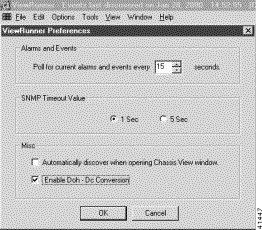
Step 5 Choose Convert to DC Mode from the Tools menu, shown in Figure 2.

An alert window appears, shown in Figure 3. Click OK.

Step 6 Click the circle next to the type of ATU-C modules to which you want to migrate, as shown in Figure 4. Click OK.

 |
Note Mixing dual-port and quad-port xTU-C modules while running the conversion is not an option. You must have either all dual-port or quad-port xTU-C modules installed. |
Step 7 Click Start to start the conversion.
The migration software deletes the DOH-related components such as the Cisco 6110 chassis, logical pool, and xTU-C modules. This process takes several minutes.
Step 8 Click Finish when the conversion is complete.
The Finish button is no longer dimmed after the wizard completes the deletion process.
Step 9 Choose Discover 6100 from the Edit menu.
Step 10 Clear any alarms as necessary. Refer to the Cisco 6100 Series with NI-1 Alarm Summary Guide for alarm details.
Now that you have downloaded the system software onto all of the selected Cisco 6100 with NI-1 system components, you can begin the DOH to Direct Connect with a POTS splitter migration. Complete the following steps:
Step 2 Change the DOH_TO_DC flag to 1.
Step 3 Restart the ViewRunner server.
Step 4 Choose DOH-DC Migration from the File menu, shown in Figure 5.
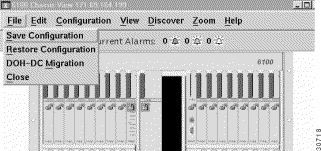
The 6100 Migration Wizard window 1 of 2 opens, shown in Figure 6.

Step 5 Click the diamond next to the Target Port Density field to which you want to migrate.
As shown in Figure 6, choosing 2 Port (dual-port) requires an ATU-C module, and choosing 4 Port (quad-port) requires a flexi ATU-C module.
 |
Note Mixing dual-port and quad-port xTU-C modules while running the migration wizard is not an option. You must have either all dual-port or quad-port xTU-C modules installed. |
Step 6 Click Next to continue.
The 6100 Migration Wizard window 2 of 2 opens.
Step 7 Click Next to start migration.
The migration software deletes the DOH-related components such as the Cisco 6110 chassis, logical pool, and xTU-C modules. This process takes several minutes.

Step 8 Click Finish when the Migration Wizard has completed deleting the DOH-related components.
The Finish button is no longer dimmed after the wizard completes the deletion process.
Step 9 Open the Chassis View and click the Discover icon for each migrated Cisco 6100 with NI-1 system.
Each system that has been migrated from DOH should show active (green tabs) dual- or quad-port modules and no Cisco 6110 chassis.
Step 10 Clear any alarms as necessary. Refer to the Cisco 6100 Series with NI-1 Alarm Summary Guide for alarm details.
Step 11 Disconnect the J45, J46, and J47 Cisco 6100 backplane cables.
Step 12 Disconnect the LIM controller module, as follows:
a. Open the chassis front cover.
b. Lift up the ejector tab to disconnect the module from the backplane.
c. Carefully slide the module forward and away from the backplane connection.
The system should not powered while you install and connect the Cisco 6100 system hardware components.
Remove power to the system with one of the following methods:
Complete the following steps to disconnect the Cisco 6120 from the MDF:
Step 2 Disconnect the voice lines by connectors (J7 to J10) from the MDF.
If the system I/O card version is not 6100-SYS-IO-3=, you will need to remove and replace the system I/O card. Complete the following steps to remove the system I/O card from the Cisco 6100 chassis backplane:
Step 2 Disconnect the ViewRunner system from the Cisco 6100 by removing the Ethernet cable from the RJ-45 connector on the system I/O card.
Step 3 Remove the coaxial cables from the two DS3 BNC connectors (J3 [TX] and J4 [RX]) for the system I/O card on the Cisco 6100 chassis backplane.
Step 4 Use a Phillips-head screwdriver to remove the two backplane screws that attach the system I/O card to the backplane. Keep these backplane screws for use when you install the plastic ESD shield.
Step 5 Lift and disconnect the system I/O card from connectors P3 and P9, two 2-mm HM module connectors on the Cisco 6100 backplane. Figure 8 shows the system I/O card removal.

If you have subtending Cisco 6100 chassis in your rack configuration and the DS3 subtending I/O card version is not 6100-ST-IO-3-DS3=, you will need to remove and replace the DS3 subtending I/O card on the back of each subtended node chassis backplane. Complete the following steps to remove the DS3 subtending I/O card from the Cisco 6100 chassis backplane:
Figure 9 shows the DS3 subtending I/O card removal.
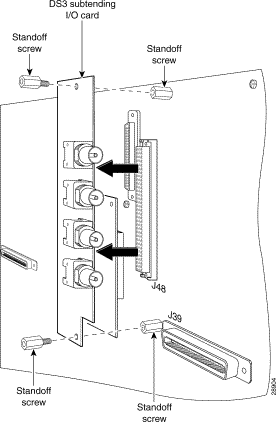
Step 2 Remove the coaxial cables from the four DS3 BNC connectors (TX1, RX1, TX2, and RX2) on the DS3 subtending I/O card.
Step 3 Use a one-quarter inch socket driver or wrench to remove the two additional standoff screws that are attached to the DS3 subtending I/O card.
Step 4 Lift and disconnect the DS3 subtending I/O card from connector J48, a 96-pin DIN connector on the subtending host chassis backplane.
Complete the following steps to disconnect the Cisco 6100 and Cisco 6110 power connections:
Step 2 Use a socket driver or a Phillips-head screwdriver to remove the clear cover over the Cisco 6110 power connections.
Step 3 Disconnect the power input connection wires connecting the Cisco 6100 chassis to the fuse and alarm panel (POS RTN and NEG DC connections) as shown in Figure 10.
You will replace these wires with a larger gauge wire later in the procedures.
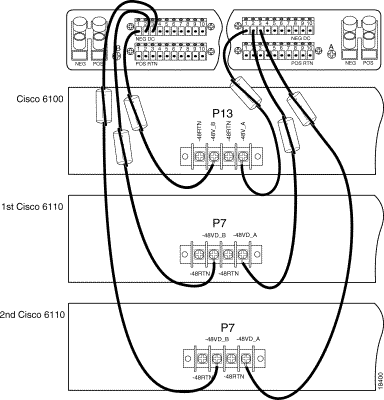
Step 4 Disconnect the power input connection wires connecting the Cisco 6110 chassis to the fuse and alarm panel (POS RTN and NEG DC connections) as shown in Figure 10.
Step 5 Disconnect the power return connection wires connecting the Cisco 6100 chassis to the fuse and alarm panel (POS RTN and NEG DC connections) as shown in Figure 11.
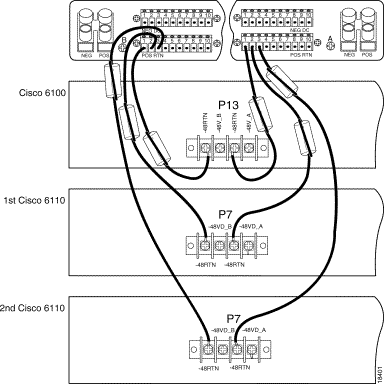
Step 6 Disconnect the power return connection wires that connect the Cisco 6100 chassis to the fuse and alarm panel (POS RTN and NEG DC connections) as shown in Figure 11.
Complete the following steps to disconnect the Cisco 6110 controller:
Step 2 Disconnect a higher Cisco 6110 in a configuration (at connector J30) from a lower Cisco 6110 (at connector J29), which are connected in a chained fashion, until you disconnect all Cisco 6110 chassis if your configuration contains more than one Cisco 6110 chassis.
Complete the following steps to disconnect the DOH data switching bus:
Step 2 Remove the cable connecting the J46 connector on the Cisco 6100 to the highest Cisco 6110 at the J26 connector.
Step 3 Remove the cable connecting successive Cisco 6110 chassis from the J27 and J28 connectors if you are using more than one Cisco 6110 chassis in your configuration.
Disconnect the Champ cables from the Cisco 6110 (connectors J21 through J24) to the Cisco 6120 (connectors J3 through J6). Table 7 shows the corresponding Cisco 6110 and Cisco 6120 connectors.
| Cisco 6110 Connector | Cisco 6120 Connector |
|---|---|
J21 | J3 |
J22 | J5 |
J23 | J6 |
J24 | J4 |
To unground the Cisco 6110 chassis perform the following procedures during installation:
If you are using more than one Cisco 6110 chassis, disconnect logic ground (connector P8) between the Cisco 6100 chassis (see the right side of Figure 12).
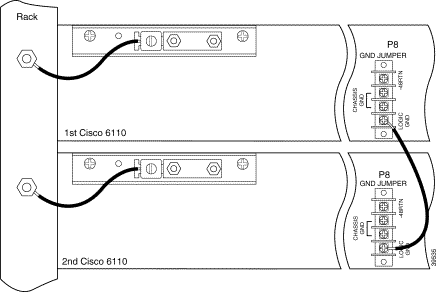
Complete the following steps to disconnect the grounding lug on the Cisco 6110 from the rack:
Step 2 Unhook the end of the copper wire that is around the screw on the rack.
Step 3 Loosen the compression screw provided on the grounding lug of the Cisco 6100. The grounding lugs are located in the upper left corner of each chassis (viewed from the rear).
Step 4 Remove the other end of the copper wire which is under the compression screw.
Step 5 Repeat Steps 1 through 5 for each Cisco 6110.
The left side of Figure 12 shows how the Cisco 6110 is grounded to the rack.
If you used ground jumper P8 on the Cisco 6110 chassis to jumper logic ground to chassis ground, or chassis ground to -48V, disconnect the return jumpers. These grounding options are not shown in Figure 12.
If you are moving the Cisco 6120 chassis up or down in the rack to accommodate a fan tray or an additional Cisco 6120 chassis, complete the following steps to disconnect the Cisco 6120 chassis ground connection:
Step 2 Unhook the end of the copper wire that is around the screw on the rack.
Step 3 Loosen the compression screw provided on the grounding lug of the Cisco 6120.
Step 4 Remove the other end of the wire.
Step 5 Tighten the compression screw.
If you are moving the Cisco 6100 chassis up or down in the rack to accommodate a fan tray or an additional Cisco 6120 chassis or have 14 AWG copper wire to connect the Cisco 6100 chassis ground, complete the following steps to disconnect the Cisco 6100 chassis ground connection:
Step 2 Unhook the end of the copper wire that is around the screw on the rack.
Step 3 Loosen the compression screw provided on the grounding lug of the Cisco 6100.
Step 4 Remove the other end of the wire.
Step 5 Tighten the compression screw.
Complete the following steps to remove the Cisco 6110 from the rack:
a. Lift up the ejector tab. This action disconnects the module from the backplane.
b. Carefully slide the module out of the slot.
 |
Note To prevent damage to the modules that are removed from the Cisco 6110, place the modules upright in a tray. |
Step 2 Use a Phillips-head screwdriver to remove the mounting screws that bolt the Cisco 6110 chassis in the rack.
Step 3 Gently remove the Cisco 6110 chassis from the rack.
If the DS3 STM version is not 6100-ST-3-DS3=, you will need to remove and replace the DS3 STM in the chassis. If you are migrating from dual-port to quad-port ATU-C modules, you need to remove the ATU-C modules as well.
Complete the following steps to remove the select modules from the Cisco 6100 chassis:
Step 2 Carefully slide the module out of the slot.
Step 3 Repeat Steps 1 and 2 for each ATU-C module (if applicable) and the DS3 STM.
When upgrading your system from a DOH configuration to a Direct Connect with a POTS splitter configuration, you may have to move the hardware components in the rack to accommodate the fan tray and a second Cisco 6120. Figure 13 shows several hardware component locations in a Direct Connect with a POTS splitter configuration using quad-port ATU-C modules.

 |
Warning Two people are required to lift the chassis. Grasp the chassis underneath the lower edge and lift with both hands. To prevent injury, keep your back straight and lift with your legs, not your back. |
Complete the following steps to measure the rack space and prepare the rack:
| Line | Instructions | Calculation |
|---|---|---|
| 1 | Total number of Cisco 6100 chassis in the rack—Maximum is two chassis per rack (include subtending host and subtended node chassis). |
|
| 2 | Total number of fan trays in the rack1—Use when installing either dual-port DMT-2 ATU-C or quad-port flexi ATU-C modules in the chassis. |
|
| 3 | Total number of POTS splitters2 in the rack. |
|
| 4 | Multiply 9 RUs by the total number of Cisco 6100 chassis on line 1. |
|
| 5 | Add 1 RU for intake plenum (1 RU for each Cisco 6100 chassis on line 1). |
|
| 6 | Multiply 2 RUs by the total number of fan trays on line 2. |
|
| 7 | Multiply 4 RUs by the total number of Cisco 6120 chassis on line 3. |
|
| 8 | Add lines 4 through 7 for the total number of RUs needed with your Direct Connect with a POTS splitter configuration using Cisco 6100 chassis. |
|
Step 2 Close and secure the Cisco 6100 rear cover (if applicable).
Step 3 Move the Cisco 6100 chassis up or down in the rack to accommodate the fan tray and additional Cisco 6120 chassis, as necessary.
a. Use a Phillips-head screwdriver to remove the mounting screws that bolt the Cisco 6100 chassis in the rack.
b. Gently move the Cisco 6100 chassis up or down in the rack to accommodate the fan tray and the additional Cisco 6120. The top of the fan tray should be flush with the bottom of the chassis.
c. Use the mounting screws and a Phillips-head screwdriver to bolt the Cisco 6100 in the rack.
Step 4 Move the existing Cisco 6120 chassis up or down in the rack to accommodate the fan tray and additional Cisco 6120, as necessary.
a. Use a Phillips-head screwdriver to remove the mounting screws that bolt the Cisco 6120 chassis in the rack.
b. Gently move the Cisco 6120 chassis up or down in the rack to accommodate the additional Cisco 6120 chassis, as shown in Figure 13.
c. Use the mounting screws and a Phillips-head screwdriver to bolt the Cisco 6120 in the rack.
Before you install the fan tray and second Cisco 6120 chassis needed for a Direct Connect with a POTS splitter configuration, you need to stabilize the rack for the new hardware components.
Verify that your Cisco 6100 with NI-1 system is installed from the bottom to the top of the rack so the rack remains stable. If your system is not installed from the bottom to the top of the rack, make the necessary adjustments to the rack as discussed in the "Install the POTS Splitter" section.
 |
Warning To prevent bodily injury when mounting or servicing this unit in a rack, you must take special precautions to ensure that the system remains stable. The following guidelines are provided to ensure your safety: - This unit should be mounted at the bottom of the rack if it is the only unit in the rack. - When mounting this unit in a partially filled rack, load the rack from the bottom to the top with the heaviest component at the bottom of the rack. - If the rack is provided with stabilizing devices, install the stabilizers before mounting or servicing the unit in the rack. |
In a Direct Connect with a POTS splitter configuration using quad-port ATU-C modules, it is necessary to expand the system to accommodate 128 ports in one of the following ways:
The following sections detail the installation procedures for each POTS splitter.
Complete the following steps to install the Cisco 6120 in the rack:
 |
Warning Two people are required to lift the chassis. Grasp the chassis underneath the lower edge and lift with both hands. To prevent injury, keep your back straight and lift with your legs, not your back. |
 |
Note The Cisco 6120 chassis ships with a retaining bar in place. Verify that the retaining bar is secure before lifting the chassis. The retaining bar prevents the modules from falling out of the chassis. |
The Cisco 6120 does not dissipate heat; therefore, the bottom of the rack is the best location for the Cisco 6120.
Step 2 Use six mounting screws and a Phillips-head screwdriver to bolt the Cisco 6120 in the rack.
Step 3 Remove the retaining bar.
Step 4 Repeat Steps 1 through 3 for each Cisco 6120 as necessary.
For installation procedures for the Siecor POTS splitter, refer to the Siecor ADSL POTS Splitter Rack-Mount Shelf Central Office Version document.
See Figure 13 for the correct placement of the Siecor POTS splitter.
 |
Warning Two people are required to lift the chassis. Grasp the chassis underneath the lower edge and lift with both hands. To prevent injury, keep your back straight and lift with your legs, not your back. |
If you are installing dual-port DMT-2 or quad-port flexi ATU-C modules in this configuration, you must have a fan tray installed directly below the Cisco 6100 chassis.
 |
Note If you are using more than one Cisco 6100 chassis in a Direct Connect with a POTS splitter configuration, you must install a fan tray under each chassis. |
Complete the following steps to install the fan tray in the rack:
Step 2 Locate the first fan module and unscrew the thumbscrew that holds the fan module in place (the screw at the top of each fan module), as shown in Figure 14.

Step 3 Carefully remove the fan module by pulling it toward you. The fan module is located on slide rails for easy removal and installation. (See Figure 15.)
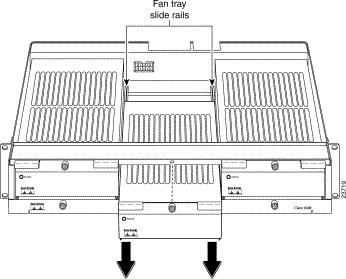
Step 4 Place the fan module on a flat and stable surface (for example, a table top) until you are ready to reinsert it into the fan tray.
Step 5 Repeat Steps 2 through 4 for each fan module.
Step 6 Position the fan tray chassis, which occupies 2 RUs of space, above the POTS splitter.
Allow an additional 1 RU of space between the fan tray and the POTS splitter. This space allows for the intake plenum.
Step 7 Use four mounting screws and a Phillips-head screwdriver to bolt the fan tray in the rack above the POTS splitter. See Figure 13 for the correct placement of the fan tray.
Step 8 Align a fan module with the fan tray slide rails inside the fan tray.
Step 9 Slide the fan module into the fan tray.
Step 10 Tighten the thumbscrew above the fan module.
Step 11 Repeat Steps 8 through 10 for each fan module.
 |
Note For information about fan module and air filter replacement, refer to the Cisco 6100 Series System Fan Tray Configuration Notes. |
A thermal guard is required when using the Cisco 6100 chassis with dual-port DMT-2 or quad-port flexi ATU-C modules.
 |
Warning Two people are required to lift the chassis. Grasp the chassis underneath the lower edge and lift with both hands. To prevent injury, keep your back straight and lift with your legs, not your back. |
 |
Note If you are using a side-by-side racks to house your configuration, you need to remove the Cisco 6100 chassis from the rack to install the thermal guard. You cannot properly secure the thermal guard with the screws if the racks are side-by-side. |
Complete the following steps to install the thermal guard on the Cisco 6100 chassis while it is in the rack:
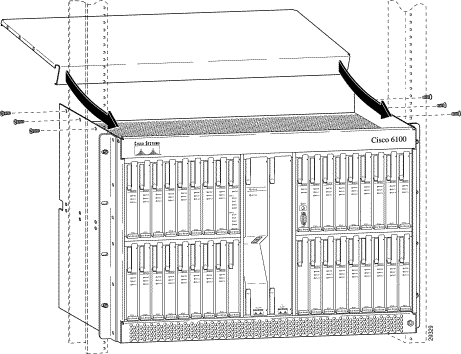
Step 2 Place the lip of the thermal guard under the lip of the Cisco 6100 chassis.
Step 3 Gently push the back of the thermal guard onto the chassis.
Step 4 Use six screws (three on each side of the chassis) to secure the thermal guard to the chassis, as shown in Figure 16.
 |
Note If you are installing the thermal guard while the chassis is in the rack, you might not be able to secure the thermal guard with all six screws. If this is the case, only the rear screw on each side is required to secure the thermal guard. |
Figure 17 shows an installed thermal guard.
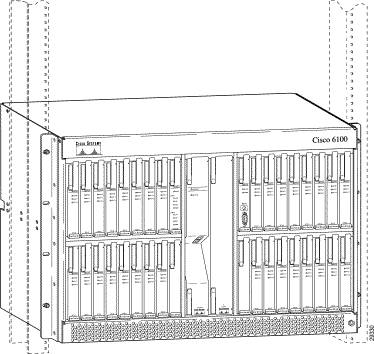
Blank faceplates should occupy any empty slots in either the Cisco 6100 or the Cisco 6120 chassis. The blank faceplate installation is similar to the module installation.
Complete the following steps to install the blank faceplates in the Cisco 6100 or Cisco 6120:
Step 2 Vertically align the blank faceplate edge with the module guides at the top and bottom of the slot.
Step 3 Lift up on the ejector tab and gently apply pressure to the bottom of the faceplate while pushing the blank faceplate into the slot.
Step 4 Push on the faceplate to fully seat the module.
Step 5 Press down on the ejector tab to secure the faceplate.
Grounding lugs are located in the upper left corners of the Cisco 6100 and Cisco 6120 and are used to ground the chassis to the rack. The one-hole lugs should be replaced by two-hole lugs and a longer bracket. Figure 18 shows the original grounding lugs.

Figure 19 shows the replacement grounding lugs on both chassis.
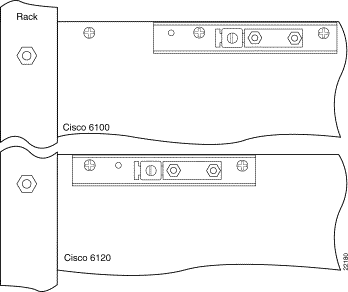
Complete the following steps to replace the grounding lugs on the Cisco 6100 chassis:
Step 2 Remove the grounding lug.
Step 3 Use a Phillips-head screwdriver to remove the screw to the right of the original grounding lug (viewing the chassis from the back).
Step 4 Use the two screws removed in Step 1 and Step 3 to attach the new, longer bracket to the Cisco 6100 chassis. These screws will be located in the second and third holes from the upper left corner of the chassis.
Step 5 Use a one-quarter inch driver or wrench and two nuts to attach the two-hole lug to the bracket.
Complete the following steps to replace the grounding lugs on the Cisco 6120 chassis:
Step 2 Remove the grounding lug.
Step 3 Use a Phillips-head screwdriver to remove the screw to the right of the original grounding lug (viewing the chassis from the back).
Step 4 Use the two screws removed in Step 1 and Step 3 to attach the new, longer bracket to the Cisco 6120 chassis. These screws will be located in the first and second holes from the upper left corner of the chassis.
Step 5 Use a one-quarter inch driver or wrench and two nuts to attach the two-hole lug to the bracket.
Complete the following steps to connect the grounding lug on the Cisco 6100, fan tray, and POTS splitter directly to the rack:
 |
Caution Do not reuse the wire you removed in the "Disconnect the Cisco 6100 Chassis Ground" section. It is necessary to upgrade the wire for the Cisco 6100 to 12 AWG or thicker. |
Step 2 Measure enough wire to connect the Cisco 6100 to the rack. Use 12 American Wire Gauge [AWG] or thicker green or green with yellow stripes stranded copper wire for the Cisco 6100 chassis grounding. Use 14 AWG or thicker green or green with yellow stripes stranded copper wire for the fan tray and POTS splitter grounding. (See Figure 20 for grounding wire location.)
 |
Tip Make sure your wire is as short as possible to make the connection. |
Step 3 Use a wire stripper to remove the casing from both ends of the wires.
Step 4 Use a 3/16-inch flat-head screwdriver to loosen the screw on the rack.
Step 5 Hook one end of the copper wire around the screw on the rack.
Step 6 Tighten the rack screw over the copper wire.
Step 7 Use a flat-head screwdriver to loosen the compression screw that is provided on the grounding lug of the Cisco 6100.
The grounding lugs are located in the upper left corner of each chassis (viewed from the rear).
Step 8 Insert the other end of the copper wire under the compression screw.
Step 9 Tighten the compression screw over the copper wire.
Step 10 Repeat Steps 1 through 9 for the fan tray and the POTS splitter (Cisco 6120).
For grounding procedures for the Siecor POTS splitter, refer to the Siecor ADSL POTS Splitter Rack-Mount Shelf Central Office Version document.
 |
Note Do not ground the components in a rack by chaining them together. |
The left side of Figure 20 shows how to ground the Cisco 6100, fan tray, and POTS splitter to the rack.
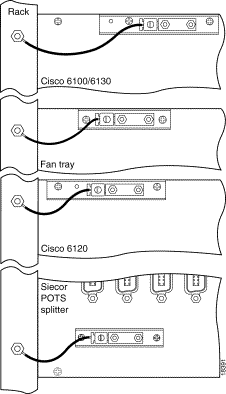
You can use the following POTS splitters in a Direct Connect with POTS splitter configuration:
The following sections detail the cabling procedures to connect the Cisco 6100 to each POTS splitter. These connections are for xDSL data flow between the Cisco 6100 and the POTS splitter.
Cisco recommends using the one-to-two cables for all new installations when connecting one Cisco 6100 chassis to one or two Cisco 6120 chassis.
 |
Note When you use the one-to-two cable, refer to the Cisco 6100 with NI-1 Direct Connect Installation Guide for port mapping information. |
Figure 21 shows the one-to-two cable.

Complete the following steps to connect the Cisco 6100 to the Cisco 6120:
Step 2 Determine which 50-pin Champ cables you will use. You can use the following cables when you are cabling the Cisco 6100 to the Cisco 6120:
 |
Note If you are using dual-port ATU-C modules, use 64-port chassis cables. However,
if you plan to expand your system to quad-port xTU-C modules for future releases,
you can use 128-port chassis cables to make future expansion easier. The 128-port
chassis cables are recommended for all new installations. If you are intermixing the modules, see to the Cisco 6100 with NI-1 Direct Connect Installation Guide for cable part numbers. |
Step 3 Connect the Champ cables from the Cisco 6100 (connectors J39 through J44) to the Cisco 6120 (connectors J1 through J6).
Table 9 lists the backplane connectors and the part numbers for the one-to-two cables. In this configuration, 64 POTS splitter ports are used in each Cisco 6120, for a total of 128 ports.
 |
Note If you are using the one-to-one cables, refer to the Cisco 6100 with NI-1 Direct Connect Installation Guide for the cabling diagrams and cable part numbers. |
| Backplane Connector | Cisco Part Number | |||||
|---|---|---|---|---|---|---|
| Cisco 6100 | First Cisco 6120 Connector | Second Cisco 6120 Connector | Kit | Subassembly | ||
| Backplane | Cable | Backplane | Cable | |||
J39 | J3 | P3A | J3 | P3B | CAB-MC128-PSC80 | 72-1767-011 |
J40 | J1 | P1A | J1 | P1B | CAB-MC128-PSC80 | 72-1767-01 |
J41 | J5 | P5A | J5 | P5B | CAB-MC128-PSC80 | 72-1767-01 |
J42 | J4 | P4A | J4 | P4B | CAB-MC128-PSC80 | 72-1768-012 |
J43 | J2 | P2A | J2 | P2B | CAB-MC128-PSC80 | 72-1769-013 |
J44 | J6 | P6A | J6 | P6B | CAB-MC128-PSC80 | 72-1770-014 |
Figure 22 shows the cabling between one Cisco 6100 and two Cisco 6120 chassis.
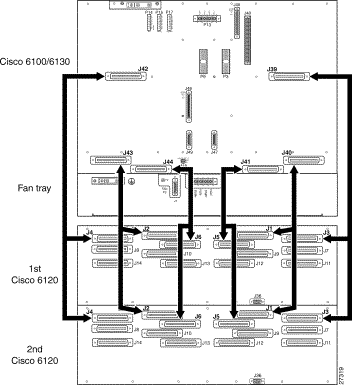
 |
Tip If you use 64 POTS splitter ports, tie wrap the second Cisco 6120 connector to the rack. When you expand your system to 128 POTS splitter ports, the second Cisco 6120 connector will attach to a second Cisco 6120. |
Use the cables described in the Cisco 6100 with NI-1 Direct Connect Installation Guide to cable the Cisco 6100 to the Siecor POTS splitter. For cabling procedures for the Siecor POTS splitter, refer to the Siecor ADSL POTS Splitter Rack-Mount Shelf Central Office Version document.
 |
Caution To prevent the system from powering up, do not install the fuses at this time. If the fuses are already installed in the fuse and alarm panel, remove them. You can replace the fuses after the system is installed and connected. |
You can wire the power connections from the Cisco 6100 to the fuse and alarm panel for either dual- or single-power feed.
 |
Note The clear cover was removed in the "Disconnect the Cisco 6100 and Cisco 6110 Power Connections" section. |
 |
Note Connect each Cisco 6100 with NI-1 system component to a separate fuse. Do not power
the components in the rack by chaining them together. Refer to the Cisco 6100 with NI-1 Direct Connect Installation Guide for the calculation tables that are necessary to determine the minimum fuse rating for each component that is wired to the fuse and alarm panel. Refer to the power rating label on the back of the Cisco 6100 to determine the maximum fuse rating. |
Complete the following steps to attach the Cisco 6100 power connections (P13) to the fuse and alarm panel for a dual-power feed:
 |
Caution Do not reuse the wire you removed in the "Disconnect the Cisco 6100 and Cisco 6110 Power Connections" section. It is necessary to upgrade to 12 AWG wire. |
Figure 23 shows the Cisco 6100 power input connections wired to the fuse and alarm panel.
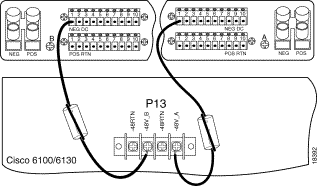
 |
Note Figure 23 shows the wires looped through a ferrite. If you use thicker wire, it will not be necessary to loop the wire through the ferrite. |
Step 2 Use a wire stripper to remove the casing from both ends of the wires.
Step 3 Use a Phillips-head screwdriver to attach a wire to the -48V_A power input connection on the Cisco 6100 (P13).
Step 4 Loop the wire through the ferrite as shown in Figure 24. If you use thicker wire, it will not be necessary to loop the wire through the ferrite.
 |
Note Looping the wire secures the ferrite. |

Step 5 Attach the wire to a fuse and alarm panel NEG (negative) DC connector.
Step 6 Use a Phillips-head screwdriver to attach a wire to the -48V_B power input connection on the Cisco 6100 (P13).
Step 7 Loop the wire through the ferrite as shown in Figure 24. If you use thicker wire, it will not be necessary to loop the wire through the ferrite.
Step 8 Attach the wire to a fuse and alarm panel NEG DC connector.
Step 9 Measure enough wire (12 AWG black and red copper solid or stranded wire) to connect each of the Cisco 6100 power return connections to the fuse and alarm panel.
Figure 25 shows the Cisco 6100 power return connections wired to the fuse and alarm panel for a dual-power feed.

 |
Note Figure 25 shows the wires looped through a ferrite. If you use thicker wire, it will not be necessary to loop the wire through the ferrite. |
Step 10 Use a wire stripper to remove the casing from both ends of the wires.
Step 11 Use a Phillips-head screwdriver to attach a wire to a -48V power return connection (-48RTN) on the Cisco 6100 (P13).
Step 12 Loop the wire through the ferrite as shown in Figure 24. If you use thicker wire, it will not be necessary to loop the wire through the ferrite.
Step 13 Attach the wire to a fuse and alarm panel POS (positive) RTN connector.
Step 14 Repeat Steps 9 through 13 for the remaining -48V power return connection (-48RTN).
Step 15 Use a socket driver or a Phillips-head screwdriver to attach the clear cover over the Cisco 6100 power connections.
Complete the following steps to attach the Cisco 6100 power connections (P13) to the fuse and alarm panel for a single-power feed:
 |
Caution Do not reuse the wire you removed in the "Disconnect the Cisco 6100 and Cisco 6110 Power Connections" section. It is necessary to upgrade to 12 AWG wire. |
Figure 26 shows the Cisco 6100 power connections wired to the fuse and alarm panel for a single-power feed.
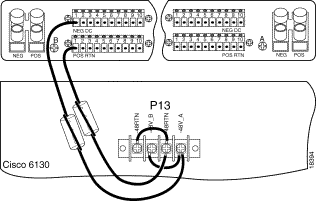
 |
Note Figure 26 shows the wires looped through a ferrite. If you use thicker wire, it will not be necessary to loop the wire through the ferrite. |
Step 2 Use a wire stripper to remove the casing from both ends of the wires.
Step 3 Use a Phillips-head screwdriver, to attach a wire to the -48V_B power input connection on the Cisco 6100 (P13).
Step 4 Loop the wire through the ferrite as shown in Figure 27. If you use thicker wire, it will not be necessary to loop the wire through the ferrite.
 |
Note Looping the wire secures the ferrite. |

Step 5 Attach the wire to the fuse and alarm panel NEG DC connector.
Step 6 Use a Phillips-head screwdriver to attach a wire to a -48RTN power return connection on the Cisco 6100 (P13). See Figure 26 for correct placement.
Step 7 Loop the wire through the ferrite as shown in Figure 27. If you use thicker wire, it will not be necessary to loop the wire through the ferrite.
Step 8 Attach the wire to the fuse and alarm panel POS RTN connector. See Figure 26 for correct placement.
Step 9 Use a Phillips-head screwdriver to attach a wire to connect the -48V_A and -48V_B power input connections to each other.
Step 10 Use a Phillips-head screwdriver to attach a wire to connect the -48RTN power return connections to each other.
Step 11 Use a socket driver or a Phillips-head screwdriver to attach the clear cover over the Cisco 6100 power connections.
Power is fed from the fuse and alarm panel to the fan tray by a terminal block connector with four dual power connections (P1) located at the top of the fan tray backplane. Figure 28 shows the location of the power connection (P1) on the fan tray.
 |
Note The fuse and alarm panel and wires are not provided by Cisco Systems, Inc. |

 |
Note Connect each Cisco 6100 with NI-1 system component to a separate fuse. Do not power
the components in the rack by chaining them together. Refer to the Cisco 6100 with NI-1 Direct Connect Installation Guide for the calculation tables that are necessary to determine the minimum fuse rating for each component that is wired to the fuse and alarm panel. Refer to the power rating label on the back of the Cisco 6100 to determine the maximum fuse rating. |
You can wire the power connections from the fuse and alarm panel to the fan tray for either dual- or single-power feed.
Complete the following steps to attach the fan tray power connections to the fuse and alarm panel for a dual-power feed:
Step 2 Measure enough wire (14 to 18 AWG copper solid or stranded wire) to connect each of the fan tray power connections to the fuse and alarm panel.
Figure 29 shows the power connections from the fan tray to the fuse and alarm panel for a dual-power feed.

Step 3 Use a wire stripper to remove the casing from both ends of the wires.
Step 4 Use a Phillips-head screwdriver to attach a wire to the -48VA power input connection on the fan tray (P1).
Step 5 Attach the wire to the fuse and alarm panel NEG DC connector. See Figure 29 for correct placement.
Step 6 Use a Phillips-head screwdriver to attach a wire to the -48VB power input connection on the fan tray (P1).
Step 7 Attach the wire to the fuse and alarm panel NEG DC connector. See Figure 29 for correct placement.
Step 8 Use a Phillips-head screwdriver to attach a wire to an RTN power return connection on the fan tray (P1).
Step 9 Attach the wire to a fuse and alarm panel POS RTN connector.
Step 10 Repeat Steps 8 and 9 for the remaining RTN power return connection.
Step 11 Use a socket driver or a Phillips-head screwdriver to attach the clear cover over the fan tray power connections.
Complete the following steps to attach the fan tray power connections to the fuse and alarm panel for a single-power feed:
Step 2 Measure enough wire (14 to 18 AWG copper solid or stranded wire) to connect each of the fan tray power connections to the fuse and alarm panel.
Figure 30 shows the power connections from the fan tray to the fuse and alarm panel for a single-power feed.
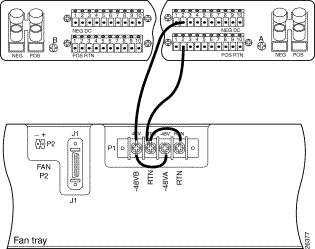
Step 3 Use a wire stripper to remove the casing from both ends of the wires.
Step 4 Use a Phillips-head screwdriver to attach a wire to the -48VA power input connection on the fan tray (P1).
Step 5 Attach the wire to the fuse and alarm panel NEG DC connector.
Step 6 Use a Phillips-head screwdriver to attach a wire to an RTN power return connection on the fan tray (P1). See Figure 30 for correct placement.
Step 7 Attach the wire to the fuse and alarm panel POS RTN connector. See Figure 30 for correct placement.
Step 8 Use a Phillips-head screwdriver to attach a wire to connect the -48VA and -48VB power input connections to each other.
Step 9 Use a Phillips-head screwdriver to attach a wire to connect the RTN power return connections to each other.
Step 10 Use a socket driver or a Phillips-head screwdriver to attach the clear cover over the fan tray power connections.
You must connect the fan tray alarm contacts so that the fan tray alarms can be transmitted to the ViewRunner management software.
Complete the following steps to connect the fan tray alarm contacts:
Figure 31 shows how the fan tray two-position header (P2) connects to the fan tray alarm contacts (P14, pins 7 and 8) on the Cisco 6100 backplane.

See Figure 32 for a close view of the alarm contact pinouts. For pinout descriptions, see the Cisco 6100 with NI-1 Direct Connect Installation Guide.
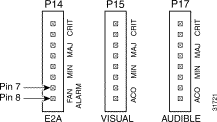
Step 2 Use a wire stripper to remove the casing from both ends of the wires.
Step 3 Wire P2 on the backplane of the fan tray to P14 (pin 7) on the backplane of the Cisco 6100 to connect the Fan Alarm+ contact. Use a wire wrapping tool to attach the wire to the contacts.
Step 4 Wire P2 on the backplane of the fan tray to P14 (pin 8) on the backplane of the Cisco 6100 to connect the Fan Alarm- contact. Use a wire wrapping tool to attach the wire to the contacts.
 |
Note Verify that the system I/O card is version 6100-SYS-IO-3. If you have the incorrect version, your configuration will not work properly. |
If you removed the system I/O card in the "Remove the System I/O Card" section, complete the following steps to install the system I/O card on the Cisco 6100 chassis backplane:
Step 2 Position and align the holes on the system I/O card over the two standoff screws on the chassis backplane and gently press the system I/O card onto the Cisco 6100 connectors P3 and P9 on the chassis backplane.
Figure 33 shows the system I/O card replacement procedures.
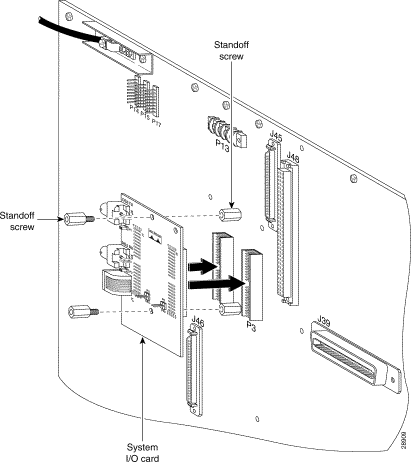
Step 3 Use a one-quarter inch socket driver or wrench to screw two additional standoff screws into the screw holes in the system I/O card and into the original standoff screws on the chassis backplane. Tighten the standoff screws using the one-quarter inch socket driver or wrench.
 |
Caution Be careful when you remove the standoff screws and reinsert the screws into the screw holes on the backplane so that the backplane circuitry does not become damaged. |
The following sections detail the cabling procedures to connect the POTS splitter to the MDF. You can use one of the following POTS splitters:
Complete the following steps to connect the Cisco 6120 to the MDF:
 |
Note Refer to the Cisco 6100 with NI-1 Direct Connect Installation Guide for more information on cabling diagrams, cable part numbers, and port mapping information. |
Step 2 Connect the xDSL subscriber line connectors (J11 to J14) to the MDF.
Step 3 Connect the voice lines by connectors (J7 to J10) to the MDF for distribution to the Public Switched Telephone Network (PSTN). Figure 34 shows the connectors used to link the Cisco 6120 to the Class 5 switch (through the MDF).

Use the cables that are described in the Cisco 6100 with NI-1 Direct Connect Installation Guide to cable the Siecor POTS splitter to the MDF. For cabling procedures for the Siecor POTS splitter, refer to the Siecor ADSL POTS Splitter Rack-Mount Shelf Central Office Version document.
Complete the following steps to pull the remaining modules in the Cisco 6100 chassis away from the chassis backplane connection:
 |
Caution If the power connections are improperly connected and power is applied while the modules are installed, the modules and chassis could be damaged. |
Step 2 Lift up the ejector tab. This action disconnects the module from the backplane.
Step 3 Carefully slide the module forward and away from the backplane connection.
Step 4 Repeat Steps 1 through 3 for the remaining modules in the Cisco 6100 chassis.
 |
Note If you are not migrating from dual-port to quad-port ATU-Cs, you also need to pull the ATU-C modules from the backplane connection. |
Verify that all of the DIP switches are set on SW1 and SW2 to the OFF position (Figure 35). The dip switches are located in the lower left corner of the backplane.
 |
Warning Systems using a Cisco 6100 chassis must connect to the network through a POTS splitter. |

 |
Note Verify that the DS3 subtending I/O card is version 6100-ST-IO-3-DS3. If you have the incorrect version, your configuration will not work properly. |
If you removed the DS3 subtending I/O card in the "Remove the DS3 Subtending I/O Card" section, complete the following steps to install the DS3 subtending I/O card on the Cisco 6100 backplane:
 |
Note Screws for mounting the DS3 subtending I/O card are already on the backplane. The standoff screws are shipped with the card. |
 |
Caution Proper ESD protection is required each time you handle Cisco DSLAM equipment. Installation and maintenance personnel should be properly grounded using ground straps to eliminate the risk of ESD damage to the equipment. Modules are subject to ESD damage each time they are removed from the chassis. |
Figure 36 shows Step 1 through Step 4.

Step 2 Use a one-quarter inch socket driver or wrench to screw two standoff screws into the locations formerly occupied by the two screws you removed in Step 1. Tighten the standoff screws using the one-quarter inch socket driver or wrench.
 |
Caution Be careful when you remove the standoff screws and reinsert the screws into the screw holes on the backplane so that the backplane circuitry does not become damaged. |
Step 3 Position and align the holes on the DS3 subtending I/O card over the two standoff screws and gently press the DS3 subtending I/O card into the Cisco 6100 connector J48 on the subtending host chassis backplane.
Step 4 Use a one-quarter inch socket driver or wrench to screw two additional standoff screws into the screw holes in the DS3 subtending I/O card and into the original standoff screws added in Step 2. Tighten the standoff screws using the one-quarter inch socket driver or wrench.
If you removed the DS3 subtending I/O card in the "Remove the DS3 Subtending I/O Card" section, complete the following steps to cable the system I/O card to the DS3 subtending I/O card:

Step 2 Add ferrites to the coaxial cables that you use to cable the DS3 subtending I/O card to the system I/O card. If you are using

 |
Note The minimum bend radius for thin type 735A coaxial cable or equivalent is
one-quarter of an inch. If the minimum bend radius exceeds one-quarter of an
inch, the cable might not work properly. Looping the wire secures the ferrite. |
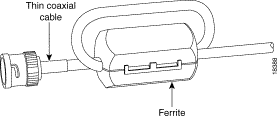
Step 3 Attach a ferrite as close as possible to the remaining end of the cable (see Figure 38 or Figure 39 for ferrite installation). Tie wrap the cable directly behind the ferrite, as necessary.
Step 4 Attach the end of the cable that is used in Step 3 to the receive DS3 BNC connector (RX) for the system I/O card on the subtended node chassis backplane.
Step 5 Attach one end of a coaxial cable to the receive DS3 BNC connector (RX1) for the DS3 subtending I/O card on the subtending host chassis backplane.
Step 6 Attach the ferrite as close as possible to the receive DS3 BNC connector (RX1) on the DS3 subtending I/O card (see Figure 38 or Figure 39 for ferrite installation). Tie wrap the cable directly behind the ferrite, as necessary.
Step 7 Attach a ferrite as close as possible to the remaining end of the cable (see Figure 38 or Figure 39 for ferrite installation). Tie wrap the cable directly behind the ferrite, as necessary.
Step 8 Attach the end of the cable that is used in Step 7 to the transmit DS3 BNC connector (TX) for the system I/O card on the subtended node chassis backplane.
Step 9 Tie wrap the transmit and receive cables coming from the DS3 subtending I/O card where the cables meet after coming from the ferrites and every 1 foot thereafter for a total of 15 feet, as shown in Figure 40.

Step 10 Tie wrap the transmit and receive cables coming from the system I/O card where the cables meet after coming from the ferrites and every 1 foot thereafter for a total of 15 feet, as shown in Figure 41.
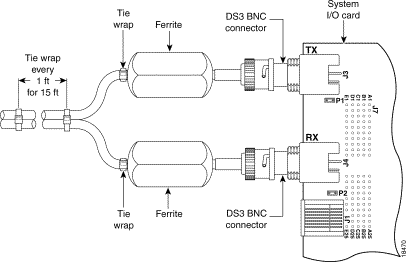
 |
Note If you have one subtending host chassis with two subtended node chassis, the second subtended node chassis connects to the TX2 and RX2 DS3 BNC connectors on the DS3 subtending I/O card. |
Step 11 Install the plastic ESD shield over the DS3 subtending I/O card using the following steps:
a. Position the holes in the plastic ESD shield over the existing standoff screws installed on the DS3 subtending I/O card.
b. Use a Phillips-head screwdriver and the backplane screws you removed in the Step 1 to attach the plastic ESD shield to the DS3 subtending I/O card (see Figure 42).
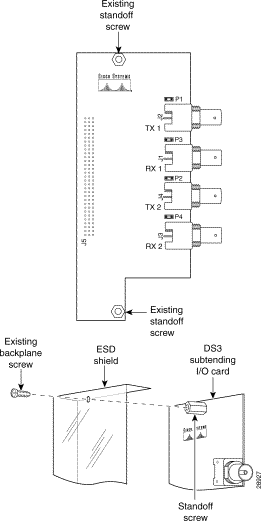
Step 12 Repeat Steps 1 through 11 for each subtending host chassis to subtended node chassis connection.
A thermal shield is required between the two shelves of the Cisco 6100 chassis to meet NEBS compliance. Complete the following steps to install the thermal shield between the chassis shelves:
Figure 43 shows the placement of the thermal shield in the chassis.

Step 2 Insert the right rear corner of the thermal shield first to create a gap. Continue to push the shield between the guide plates as far as possible.
 |
Note Some force is required to separate the guide plates during insertion. |
Step 3 Use the second shield or a flat head screw driver to push the thermal shield in until it drops onto the lower module guides.
Step 4 Repeat the Step 1 through Step 3 for the right side of the chassis.
Complete the following steps to apply power to the Cisco 6100 with NI-1 system:
Step 2 Apply power to the system with one of the following methods:
 |
Caution If the power connections are improperly connected and power is applied while the modules are installed, the modules and chassis could be damaged. |
Step 3 Verify that the power connections from the Cisco 6100 to the fuse and alarm panel are wired as shown in Figure 25 or Figure 26.
Step 4 Verify that the power connections from the fan tray to the fuse and alarm panel are wired as shown in Figure 29 or Figure 30.
Step 5 Check the polarity of the -48 VDC connections to each chassis by attaching a voltmeter with the minus lead on -48RTN and the plus lead on -48V_A. Ensure that the meter reads between -36 VDC and -60 VDC. If your voltmeter shows a positive voltage, the power inputs might be reversed. If the voltmeter shows a negative voltage that is out of the -36 VDC to -60 VDC range, check the power supply for failure or check for a blown fuse in the fuse and alarm panel.
Verify that the fans are operational by locating the LED on the front of each fan. If the LED is
The fans should be operational before you install the modules.
 |
Caution It is important that the Cisco 6100 cooling fans run continuously. |
 |
Warning The power supply circuitry for the Cisco DSLAM equipment can constitute an energy hazard. Before you install or replace the equipment, remove all jewelry (including rings, necklaces, and watches). Metal objects can come into contact with exposed power supply wiring or circuitry inside the DSLAM equipment. This could cause the metal objects to heat up and cause serious burns or weld the metal object to the equipment. |
 |
Warning Do not reach into a vacant slot or chassis while you install or removing a module or a fan. Exposed circuitry could constitute an energy hazard. |
If you use dual-port CAP ATU-C modules in the Cisco 6100 chassis, you need to change the jumper blocks from a DOH configuration to a Direct Connect configuration.
 |
Note The DMT-2 or flexi ATU-C modules do not contain jumper blocks. |
Complete the following steps to change the jumper block location on the CAP ATU-C modules:

Step 2 Remove the jumper blocks and place them on the CAP ATU-C module in the proper location.
Step 3 Repeat Steps 1 and 2 for each CAP ATU-C module in the chassis.
 |
Caution Proper ESD protection is required each time you handle Cisco DSLAM equipment. Installation and maintenance personnel should be properly grounded using ground straps to eliminate the risk of ESD damage to the equipment. Modules are subject to ESD damage each time they are removed from the chassis. |
 |
Note If you are migrating from dual-port to quad-port ATU-Cs, you need to install the new flexi ATU-C modules. |
Install the Cisco 6100 Series modules in the following order to verify the power connection and to ensure that the ViewRunner discovery feature works properly. Refer to the ViewRunner for Windows Direct Connect Provisioning Guide or the ViewRunner for HP OpenView Direct Connect Provisioning Guide for more information on the discovery feature.
 |
Caution Installing the modules in the chassis with the power leads reversed can damage the modules. |
 |
Warning The power supply circuitry for the Cisco DSLAM equipment can constitute an energy hazard. Before you install or replace the equipment, remove all jewelry (including rings, necklaces, and watches). Metal objects can come into contact with exposed power supply wiring or circuitry inside the DSLAM equipment. This could cause the metal objects to heat up and cause serious burns or weld the metal object to the equipment. |
 |
Warning Do not reach into a vacant slot or chassis while you install or remove a module or a fan. Exposed circuitry could constitute an energy hazard. |
 |
Note All modules must be fully seated in the chassis. A push on the faceplate of each module is required for the module to be fully seated. |
To install all of the modules, complete the following steps. It is important that you accomplish each step completely before moving on to the next step.
a. Vertically align the module edge with the module guides at the top and bottom of the Cisco 6100 slot.
b. Lift up on the ejector tab and gently apply pressure to the bottom of the faceplate while pushing the module into the slot.
c. Push on the faceplate of each module to fully seat the module.
d. Press down on the ejector tab to secure the module and connect it to the backplane.
e. Lock the flexi ATU-C modules.
 |
Note It is not necessary to lock the flexi ATU-C modules. |

f. Install the remaining ATU-C modules using the same procedure.
Step 2 Install a DS3 STM (version 6100-ST-3-DS3) in the Cisco 6100.
a. Vertically align the module edge with the module guides at the top and bottom of slot 9 of the Cisco 6100 chassis.
b. Lift up on the ejector tab and gently apply pressure to the bottom of the faceplate while pushing the module into the slot.
c. Push on the faceplate of each module to fully seat the module.
d. Press down on the ejector tab to secure the module and connect it to the backplane.
Step 3 Install the POTS splitter modules in the Cisco 6120.
a. Vertically align the module edge with the module guides at the top and bottom of slot 1 on the Cisco 6120.
b. Lift up on the ejector tab and gently apply pressure to the bottom of the faceplate while pushing the module into the slot.
c. Push on the faceplate of each module to fully seat the module.
d. Press down on the ejector tab to secure the module and connect it to the backplane.
e. Install the remaining POTS modules using the same procedure.
 |
Caution Proper ESD protection is required each time you handle Cisco DSLAM equipment. Installation and maintenance personnel should be properly grounded using ground straps to eliminate the risk of ESD damage to the equipment. Modules are subject to ESD damage each time they are removed from the chassis. |
 |
Note If you are not migrating from dual-port to quad-port ATU-Cs, you also need to reseat the ATU-C modules. |
To reseat the modules, complete the following steps. It is important that you accomplish each step completely before moving on to the next step.
 |
Note All modules must be fully seated in the chassis. A push on the faceplate of each module is required for the module to be fully seated. |
a. Verify that the jumper blocks are in the correct position on the dual-port CAP ATU-C modules (see the "Change the Dual-Port CAP ATU-C Jumpering" section).
b. Lift up on the ejector tab and gently apply pressure to the bottom of the faceplate while pushing the module into the slot.
c. Push on the faceplate of each module to fully seat the module.
d. Press down on the ejector tab to secure the module and connect it to the backplane.
e. Reseat the remaining xTU-C modules using the same procedure.
Step 2 Reseat the NI-1 module in the Cisco 6100.
a. Lift up on the ejector tabs and gently apply pressure to the bottom of the faceplate while pushing the module into the slot.
b. Push on the faceplate of each module to fully seat the module.
c. Press down on the ejector tabs to secure the module and connect it to the backplane.
Step 3 Reseat the system controller module in the Cisco 6100.
a. Lift up on the ejector tab and gently apply pressure to the bottom of the faceplate while pushing the module into the slot.
b. Push on the faceplate of each module to fully seat the module.
c. Press down on the ejector tab to secure the module and connect it to the backplane. This causes each module in the Cisco 6100 to reset.
Step 4 Verify that the STATUS LEDs on all modules are solid green (where applicable).
This self-test procedure takes several minutes. Verify that there are no alarms on the system controller module (ALARM LED off). If the STATUS LEDs are not green after the self-test, refer to the Cisco 6100 with NI-1 Direct Connect Installation Guide for troubleshooting procedures.
Step 5 Perform a software update using the ViewRunner software if the STATUS LEDs on the xTU-C modules or the NI-1 module are flashing.
Refer to the ViewRunner for Windows Direct Connect Provisioning Guide or the ViewRunner for HP OpenView Direct Connect Provisioning Guide for software upgrade procedures.
This section provides installation procedures for the OC-3c and DS3 network connections.
Complete the following steps to connect the OC-3c NI-1 module to the network using an OC-3c connection:
 |
Warning Do not stare into the beam or view it directly with optical instruments. |
Step 2 Remove the fiber that was temporarily installed to loop back the interface in the "Install the New Modules" section.
Step 3 Pull the OC-3c NI-1 module transmit and receive cables from the ATM switch through the 1 RU of space between the fan tray and the POTS splitter.
Step 4 Attach the transmit optical fiber to the receive connector in the inset on the faceplate of the OC-3c NI-1 modules. See Figure 46 for the OC-3c network interface connection location.
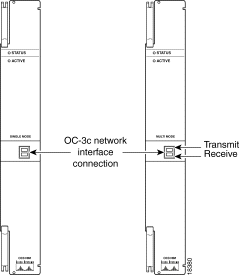
The transmit connector is the one closest to the top of the faceplate. The receive connector is closest to the bottom of the faceplate. The connector IDs are silkscreened inside the inset.
Step 5 Attach the receive optical fiber to the transmit connector in the inset on the faceplate of the OC-3c NI-1 modules.
Step 6 Allow enough slack in the cable so that the fan tray can be opened and the fans can be maintained.
Step 7 Coil the fiber loosely within the 1 RU of space to take out slack.
Complete the following steps to connect the DS3 NI-1 module to the network:
The DS3 NI-1 module connections are on the system I/O card, which is located on the backplane of the Cisco 6100 chassis. These connections attach to the ATM switch. Two 75-ohm DS3 Bayonet-Neill-Concelman (BNC) connectors are provided for DS3 transmit (J3) and receive (J4). See Figure 47 for the location of the DS3 BNC connectors.
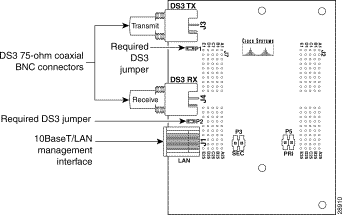
 |
Note There are two DS3 jumpers on the system I/O card. The DS3 jumpers connect the BNC shield to the chassis ground. Both the receive DS3 jumper (P2) and the transmit DS3 jumper (P1) are installed on the system I/O card when it ships. |
Step 2 Remove the short coaxial cable between the DS3 transmit and receive connectors that you attached when you installed the system controller module in the "Install the New Modules" section.
Step 3 Attach one end of a coaxial cable (type 734A, type 735A, or equivalent) to the transmit DS3 BNC connector (J3) for the system I/O card on the chassis backplane.
 |
Note Currently only the internal clock on the DS3 NI-1 module is used. The clock is hard-coded in the system software. |
Step 4 Add ferrites to the coaxial cables that you use to cable the system I/O card to the ATM switch. If you are using

 |
Note The minimum bend radius for thin type 735A coaxial cable or equivalent is
one-quarter of an inch. If the minimum bend radius exceeds one-quarter of an
inch, the cable might not work properly. Looping the wire secures the ferrite. |

Step 5 Attach the end of the cable that is used in Step 3, which originates at the transmit DS3 BNC connector, to the ATM switch.
Step 6 Attach one end of a coaxial cable (type 734A, type 735A, or equivalent) to the receive DS3 BNC connector (J4) for the system I/O card on the Cisco 6100 backplane.
Step 7 Attach the ferrite as close as possible to the receive DS3 BNC connector on the system I/O card (see Figure 48 or Figure 49 for ferrite installation). Tie wrap the cable directly behind the ferrite, as necessary.
Step 8 Attach the end of the cable that is used in Step 6, which originates at the receive DS3 BNC connector, to the ATM switch.
Step 9 Tie wrap the transmit and receive cables coming from the system I/O card where the cables meet after coming from the ferrites and every 1 foot thereafter for a total of 15 feet, as shown in Figure 50.

Complete the following steps to attach the Cisco 6100 chassis ventilation cover:
Step 2 Attach the ventilation cover over the open vents on the bottom of the chassis, as shown in Figure 51.
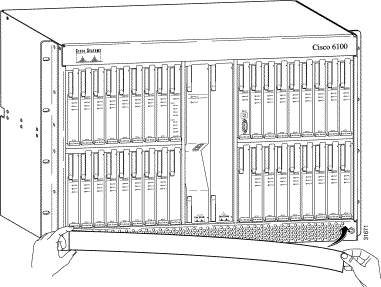
Complete the following steps to attach the new power rating label:
Step 2 Peel the backing off the new power rating label.
Step 3 Attach the new power rating label directly over the current power rating on your chassis, as shown in Figure 52.
Ensure that the 'C' on the current power rating is not covered by the new label.
 |
Note If you cannot locate your current power rating label, please attach the new power rating label to the backplane plastic cover. |
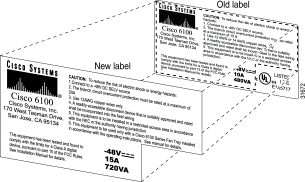
The Cisco 6100 front cover needs to be attached and closed. Complete the following steps to replace the front cover of the Cisco 6100 chassis with a new stiffened cover and EMI gaskets:
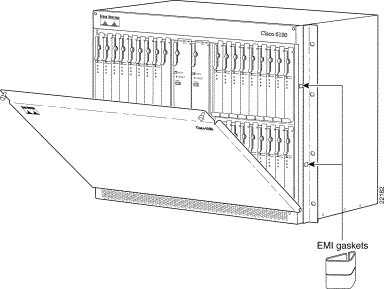
Step 2 Add two EMI gaskets to either side of the chassis frame in the positions shown in Figure 53.
Step 3 Use the two thumbscrews in the upper corners of the cover to close it firmly over the front of the chassis.
Complete the following steps to connect the ViewRunner system to the Cisco 6100:
Step 2 Connect the other end of the Ethernet cable to one of the following:
 |
Note If you are connecting the Ethernet cable to a PC, you need a crossover cable. |
Step 3 Install the plastic ESD shield over the system I/O card using the following steps:
a. Position the holes in the plastic ESD shield over the existing standoff screws installed on the system I/O card.
b. Use a Phillips-head screwdriver and the backplane screws to attach the plastic ESD shield to the system I/O card (see Figure 54). You removed these backplane screws in the "Remove the System I/O Card" section.

 |
Tip For step-by-step instructions for provisioning a Direct Connect configuration, refer the ViewRunner for Windows Direct Connect Provisioning Guide or the ViewRunner for HP OpenView Direct Connect Provisioning Guide. |
Complete the following steps to close the optional rear cover:
Step 2 Lift the two latches on the rear cover (as shown in Figure 55) as you close the rear cover. The rear cover closes left to right (seen from the rear of the chassis).

Step 3 Release the latches after the rear cover is in place.
Step 4 Align the two thumbscrews that are located on the rear cover with two thumbscrew fasteners on the bracket (see Figure 56). Tighten the thumbscrews to secure the rear cover.
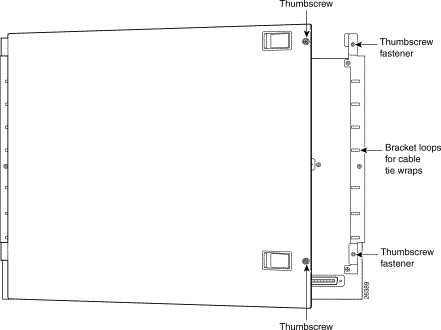
The grounding symbols, CLEI codes, and Cisco 6120 800 number labels included in the kit need to replace the current labels on each chassis. Figure 57 shows the positions of the labels being replaced.
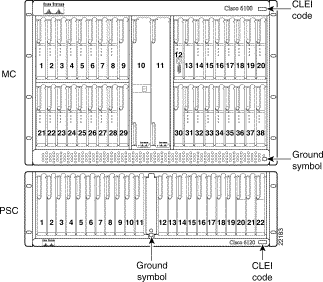
Complete the following steps to replace the proper labels on the Cisco 6100:
Step 2 Replace the 800-04390-02 label on the right side of the chassis with the new 800-04390-03 label.
Step 3 Replace the original ground symbol label in the lower right corner of the chassis with the new one.
Complete the following steps to replace the proper labels on the Cisco 6120.
Step 2 Replace the 800-04325-03 label on the right side of the chassis with the new 800-04325-04 label.
Step 3 Replace the original ground symbol label in the lower center of the chassis with the new one.
To verify that the system is connected and running properly, follow the connection test procedures in the Cisco 6100 with NI-1 Direct Connect Installation Guide.
Table 10 maps the Cisco 6100 ports, the Cisco 6120 ports for two Cisco 6120 chassis, and the wire pairs when using the one-to-two cables (see Table 9) for a Direct Connect with a POTS splitter configuration. The corresponding cable kit number is CAB-MC128-PSC80. You can use the one-to-two cables to connect one Cisco 6100 to two Cisco 6120 chassis for systems using quad-port ATU-C modules.
| Cisco 6100 Slot/Line | Cisco 6120 Slot/Line | Champ Pins | Cisco 6120 MDF/ POTS Connection | ||
|---|---|---|---|---|---|
| Cisco 6120 Chassis 1 | Cisco 6120 Chassis 2 | Tip | Ring | ||
1/1 | 1/1 | — | 9 | 34 | J11/J7 |
1/2 | 1/2 | — | 10 | 35 | |
1/3 | — | 1/1 | 9 | 34 | |
1/4 | — | 1/2 | 10 | 35 | |
2/1 | 1/3 | — | 11 | 36 | |
2/2 | 1/4 | — | 12 | 37 | |
2/3 | — | 1/3 | 11 | 36 | |
2/4 | — | 1/4 | 12 | 37 | |
3/1 | 2/1 | — | 5 | 30 | |
3/2 | 2/2 | — | 6 | 31 | |
3/3 | — | 2/1 | 5 | 30 | |
3/4 | — | 2/2 | 6 | 31 | |
4/1 | 2/3 | — | 7 | 32 | |
4/2 | 2/4 | — | 8 | 33 | |
4/3 | — | 2/3 | 7 | 32 | |
4/4 | — | 2/4 | 8 | 33 | |
5/1 | 3/1 | — | 1 | 26 | |
5/2 | 3/2 | — | 2 | 27 | |
5/3 | — | 3/1 | 1 | 26 | |
5/4 | — | 3/2 | 2 | 27 | |
6/1 | 3/3 | — | 3 | 28 | |
6/2 | 3/4 | — | 4 | 29 | |
6/3 | — | 3/3 | 3 | 28 | |
6/4 | — | 3/4 | 4 | 29 | |
7/1 | 4/1 | — | 18 | 43 | |
7/2 | 4/2 | — | 19 | 44 | |
7/3 | — | 4/1 | 18 | 43 | |
7/4 | — | 4/2 | 19 | 44 | |
8/1 | 4/3 | — | 20 | 45 | |
8/2 | 4/4 | — | 21 | 46 | |
8/3 | — | 4/3 | 20 | 45 | |
8/4 | — | 4/4 | 21 | 46 | |
13/1 | 19/1 | — | 18 | 43 | J14/J8 |
13/2 | 19/2 | — | 19 | 44 | |
13/3 | — | 19/1 | 18 | 43 | |
13/4 | — | 19/2 | 19 | 44 | |
14/1 | 19/3 | — | 20 | 45 | |
14/2 | 19/4 | — | 21 | 46 | |
14/3 | — | 19/3 | 20 | 45 | |
14/4 | — | 19/4 | 21 | 46 | |
15/1 | 20/1 | — | 1 | 26 | |
15/2 | 20/2 | — | 2 | 27 | |
15/3 | — | 20/1 | 1 | 26 | |
15/4 | — | 20/2 | 2 | 27 | |
16/1 | 20/3 | — | 3 | 28 | |
16/2 | 20/4 | — | 4 | 29 | |
16/3 | — | 20/3 | 3 | 28 | |
16/4 | — | 20/4 | 4 | 29 | |
17/1 | 21/1 | — | 5 | 30 | |
17/2 | 21/2 | — | 6 | 31 | |
17/3 | — | 21/1 | 5 | 30 | |
17/4 | — | 21/2 | 6 | 31 | |
18/1 | 21/3 | — | 7 | 32 | |
18/2 | 21/4 | — | 8 | 33 | |
18/3 | — | 21/3 | 7 | 32 | |
18/4 | — | 21/4 | 8 | 33 | |
19/1 | 22/1 | — | 9 | 34 | |
19/2 | 22/2 | — | 10 | 35 | |
19/3 | — | 22/1 | 9 | 34 | |
19/4 | — | 22/2 | 10 | 35 | |
20/1 | 22/3 | — | 11 | 36 | |
20/2 | 22/4 | — | 12 | 37 | |
20/3 | — | 22/3 | 11 | 36 | |
20/4 | — | 22/4 | 12 | 37 | |
21/1 | 5/1 | — | 22 | 47 | J11/J7 |
21/2 | 5/2 | — | 23 | 48 | |
21/3 | — | 5/1 | 22 | 47 | |
21/4 | — | 5/2 | 23 | 48 | |
22/1 | 5/3 | — | 24 | 49 | |
22/2 | 5/4 | — | 25 | 50 | |
22/3 | — | 5/3 | 24 | 49 | |
22/4 | — | 5/4 | 25 | 50 | |
23/1 | 6/1 | — | 6 | 31 | J12/J9 |
23/2 | 6/2 | — | 7 | 32 | |
23/3 | — | 6/1 | 6 | 31 | |
23/4 | — | 6/2 | 7 | 32 | |
24/1 | 6/3 | — | 8 | 33 | |
24/2 | 6/4 | — | 9 | 34 | |
24/3 | — | 6/3 | 8 | 33 | |
24/4 | — | 6/4 | 9 | 34 | |
25/1 | 7/1 | — | 2 | 27 | |
25/2 | 7/2 | — | 3 | 28 | |
25/3 | — | 7/1 | 2 | 27 | |
25/4 | — | 7/2 | 3 | 28 | |
26/1 | 7/3 | — | 4 | 29 | |
26/2 | 7/4 | — | 5 | 30 | |
26/3 | — | 7/3 | 4 | 29 | |
26/4 | — | 7/4 | 5 | 30 | |
27/1 | 8/1 | — | 1 | 26 | |
27/2 | 8/2 | — | 10 | 35 | |
27/3 | — | 8/1 | 1 | 26 | |
27/4 | — | 8/2 | 10 | 35 | |
28/1 | 8/3 | — | 11 | 36 | |
28/2 | 8/4 | — | 12 | 37 | |
28/3 | — | 8/3 | 11 | 36 | |
28/4 | — | 8/4 | 12 | 37 | |
31/1 | 15/1 | — | 1 | 26 | J13/J10 |
31/2 | 15/2 | — | 10 | 35 | |
31/3 | — | 15/1 | 1 | 26 | |
31/4 | — | 15/2 | 10 | 35 | |
32/1 | 15/3 | — | 11 | 36 | |
32/2 | 15/4 | — | 12 | 37 | |
32/3 | — | 15/3 | 11 | 36 | |
32/4 | — | 15/4 | 12 | 37 | |
33/1 | 16/1 | — | 2 | 27 | |
33/2 | 16/2 | — | 3 | 28 | |
33/3 | — | 16/1 | 2 | 27 | |
33/4 | — | 16/2 | 3 | 28 | |
34/1 | 16/3 | — | 4 | 29 | |
34/2 | 16/4 | — | 5 | 30 | |
34/3 | — | 16/3 | 4 | 29 | |
34/4 | — | 16/4 | 5 | 30 | |
35/1 | 17/1 | — | 6 | 31 | |
35/2 | 17/2 | — | 7 | 32 | |
35/3 | — | 17/1 | 6 | 31 | |
35/4 | — | 17/2 | 7 | 32 | |
36/1 | 17/3 | — | 8 | 33 | |
36/2 | 17/4 | — | 9 | 34 | |
36/3 | — | 17/3 | 8 | 33 | |
36/4 | — | 17/4 | 9 | 34 | |
37/1 | 18/1 | — | 22 | 47 | J14/J8 |
37/2 | 18/2 | — | 23 | 48 | |
37/3 | — | 18/1 | 22 | 47 | |
37/4 | — | 18/2 | 23 | 48 | |
38/1 | 18/3 | — | 24 | 49 | |
38/2 | 18/4 | — | 25 | 50 | |
38/3 | — | 18/3 | 24 | 49 | |
38/4 | — | 18/4 | 25 | 50 | |
A complete list of all DSL product related documentation is available on the World Wide Web at http://www.cisco.com/univercd/cc/td/doc/product/dsl_prod/index.htm
The following sections provide sources for obtaining documentation from Cisco Systems.
You can access the most current Cisco documentation on the World Wide Web at http://www.cisco.com, http://www-china.cisco.com, or http://www-europe.cisco.com.
Cisco documentation and additional literature are available in a CD-ROM package, which ships with your product. The Documentation CD-ROM is updated monthly. Therefore, it is probably more current than printed documentation. The CD-ROM package is available as a single unit or as an annual subscription.
Registered CCO users can order the Documentation CD-ROM and other Cisco Product documentation through our online Subscription Services at http://www.cisco.com/cgi-bin/subcat/kaojump.cgi.
Nonregistered CCO users can order documentation through a local account representative by calling Cisco's corporate headquarters (California, USA) at 408 526-4000 or, in North America, call 800 553-NETS (6387).
Cisco provides Cisco Connection Online (CCO) as a starting point for all technical assistance. Warranty or maintenance contract customers can use the Technical Assistance Center. All customers can submit technical feedback on Cisco documentation using the web, e-mail, a self-addressed stamped response card included in many printed docs, or by sending mail to Cisco.
Cisco continues to revolutionize how business is done on the Internet. Cisco Connection Online is the foundation of a suite of interactive, networked services that provides immediate, open access to Cisco information and resources at anytime, from anywhere in the world. This highly integrated Internet application is a powerful, easy-to-use tool for doing business with Cisco.
CCO's broad range of features and services helps customers and partners to streamline business processes and improve productivity. Through CCO, you will find information about Cisco and our networking solutions, services, and programs. In addition, you can resolve technical issues with online support services, download and test software packages, and order Cisco learning materials and merchandise. Valuable online skill assessment, training, and certification programs are also available.
Customers and partners can self-register on CCO to obtain additional personalized information and services. Registered users may order products, check on the status of an order and view benefits specific to their relationships with Cisco.
You can access CCO in the following ways:
You can e-mail questions about using CCO to cco-team@cisco.com.
The Cisco Technical Assistance Center (TAC) is available to warranty or maintenance contract customers who need technical assistance with a Cisco product that is under warranty or covered by a maintenance contract.
To display the TAC web site that includes links to technical support information and software upgrades and for requesting TAC support, use www.cisco.com/techsupport.
To contact by e-mail, use one of the following:
| Language | E-mail Address |
|---|---|
English | tac@cisco.com |
Hanzi (Chinese) | chinese-tac@cisco.com |
Kanji (Japanese) | japan-tac@cisco.com |
Hangul (Korean) | korea-tac@cisco.com |
Spanish | tac@cisco.com |
Thai | thai-tac@cisco.com |
In North America, TAC can be reached at 800 553-2447 or 408 526-7209. For other telephone numbers and TAC e-mail addresses worldwide, consult the following web site: http://www.cisco.com/warp/public/687/Directory/DirTAC.shtml.
If you are reading Cisco product documentation on the World Wide Web, you can submit technical comments electronically. Click Feedback in the toolbar and select Documentation. After you complete the form, click Submit to send it to Cisco.
You can e-mail your comments to bug-doc@cisco.com.
To submit your comments by mail, for your convenience many documents contain a response card behind the front cover. Otherwise, you can mail your comments to the following address:
Cisco Systems, Inc.
Document Resource Connection
170 West Tasman Drive
San Jose, CA 95134-9883
We appreciate and value your comments.
This document is to be used in conjunction with the documents listed in the "Related Documentation" section.
Access Registrar, AccessPath, Any to Any, Are You Ready, AtmDirector, Browse with Me, CCDA, CCDE, CCDP, CCIE, CCNA, CCNP, CCSI, CD-PAC, the Cisco logo, Cisco Certified Internetwork Expert logo, CiscoLink, the Cisco Management Connection logo, the Cisco NetWorks logo, the Cisco Powered Network logo, Cisco Systems Capital, the Cisco Systems Capital logo, Cisco Systems Networking Academy, the Cisco Systems Networking Academy logo, the Cisco Technologies logo, Fast Step, FireRunner, Follow Me Browsing, FormShare, GigaStack, IGX, Intelligence in the Optical Core, Internet Quotient, IP/VC, IQ Breakthrough, IQ Expertise, IQ FastTrack, IQ Readiness Scorecard, The IQ Logo, Kernel Proxy, MGX, Natural Network Viewer, NetSonar, Network Registrar, the Networkers logo, Packet, PIX, Point and Click Internetworking, Policy Builder, Precept, RateMUX, ReyMaster, ReyView, ScriptShare, Secure Script, Shop with Me, SlideCast, SMARTnet, SVX, The Cell, TrafficDirector, TransPath, VlanDirector, Voice LAN, Wavelength Router, Workgroup Director, and Workgroup Stack are trademarks; Changing the Way We Work, Live, Play, and Learn, Empowering the Internet Generation, The Internet Economy, and The New Internet Economy are service marks; and Aironet, ASIST, BPX, Catalyst, Cisco, Cisco IOS, the Cisco IOS logo, Cisco Systems, the Cisco Systems logo, the Cisco Systems Cisco Press logo, CollisionFree, Enterprise/Solver, EtherChannel, EtherSwitch, FastHub, FastLink, FastPAD, FastSwitch, GeoTel, IOS, IP/TV, IPX, LightStream, LightSwitch, MICA, NetRanger, Post-Routing, Pre-Routing, Registrar, StrataView Plus, Stratm, TeleRouter, and VCO are registered trademarks of Cisco Systems, Inc. or its affiliates in the U.S. and certain other countries. All other trademarks mentioned in this document are the property of their respective owners. The use of the word partner does not imply a partnership relationship between Cisco and any other company. (0005R)
Copyright © 2000, Cisco Systems, Inc.
All rights reserved.
![]()
![]()
![]()
![]()
![]()
![]()
![]()
![]()
Posted: Thu Jul 25 00:56:13 PDT 2002
All contents are Copyright © 1992--2002 Cisco Systems, Inc. All rights reserved.
Important Notices and Privacy Statement.